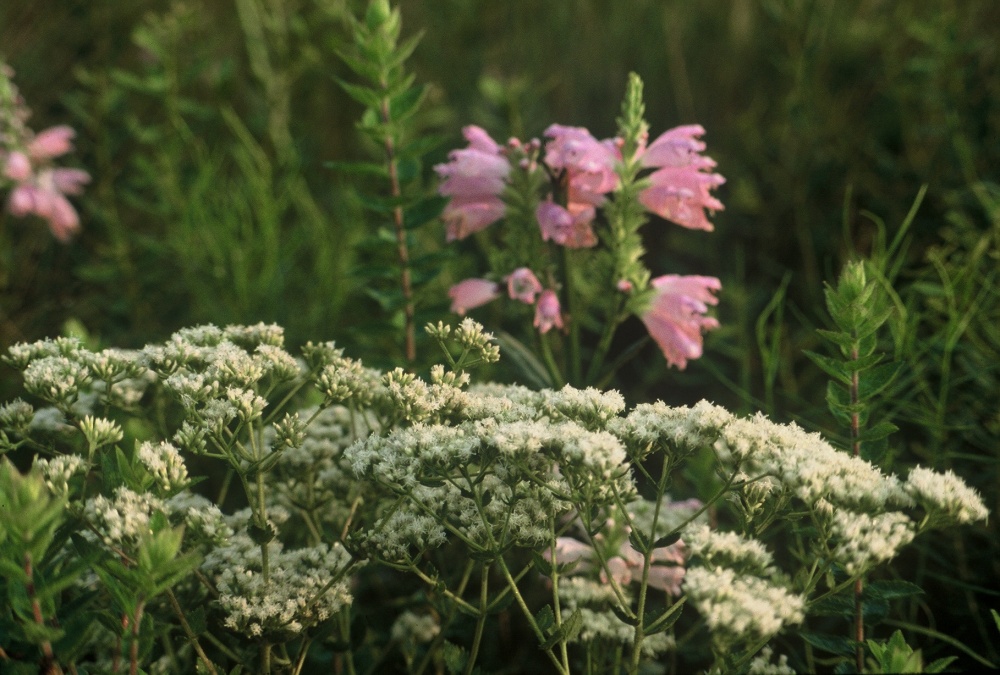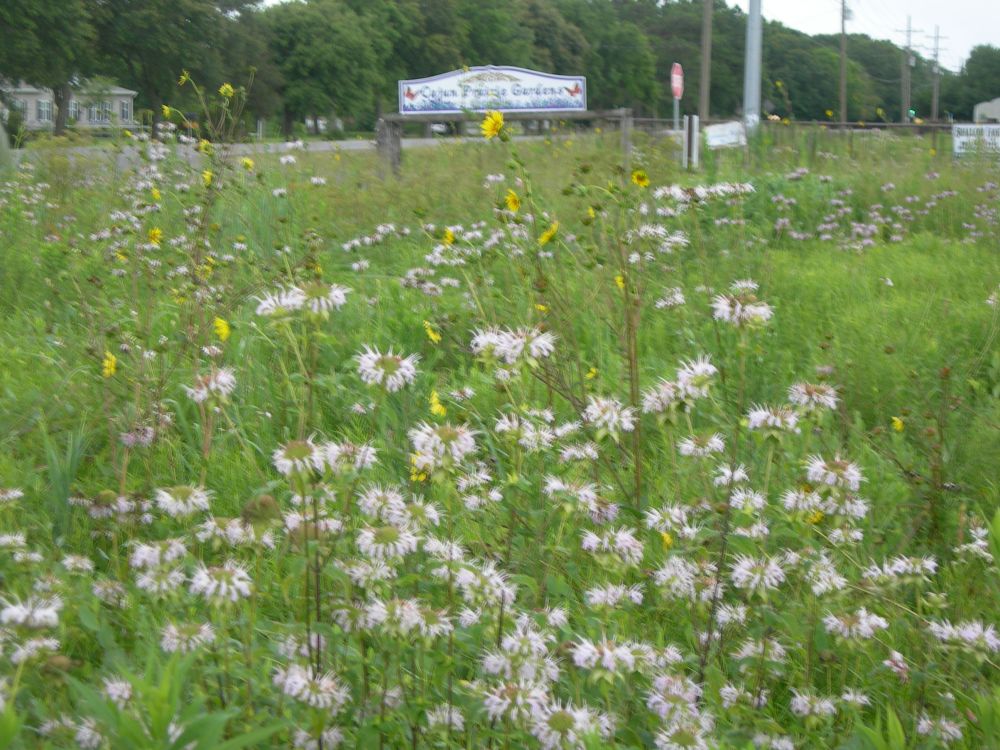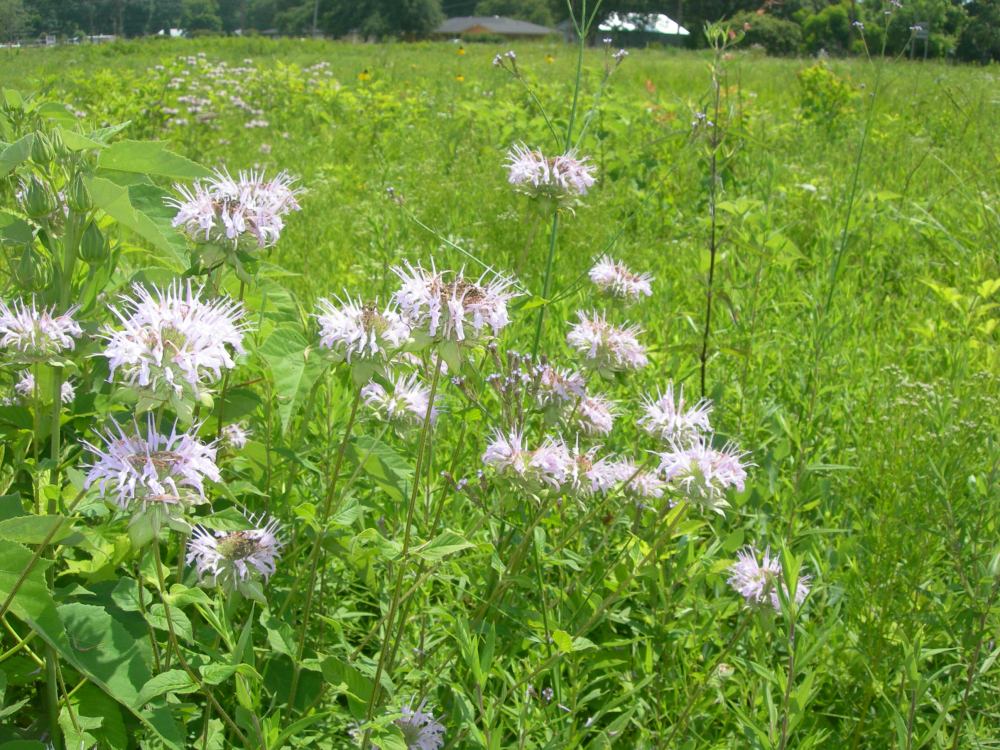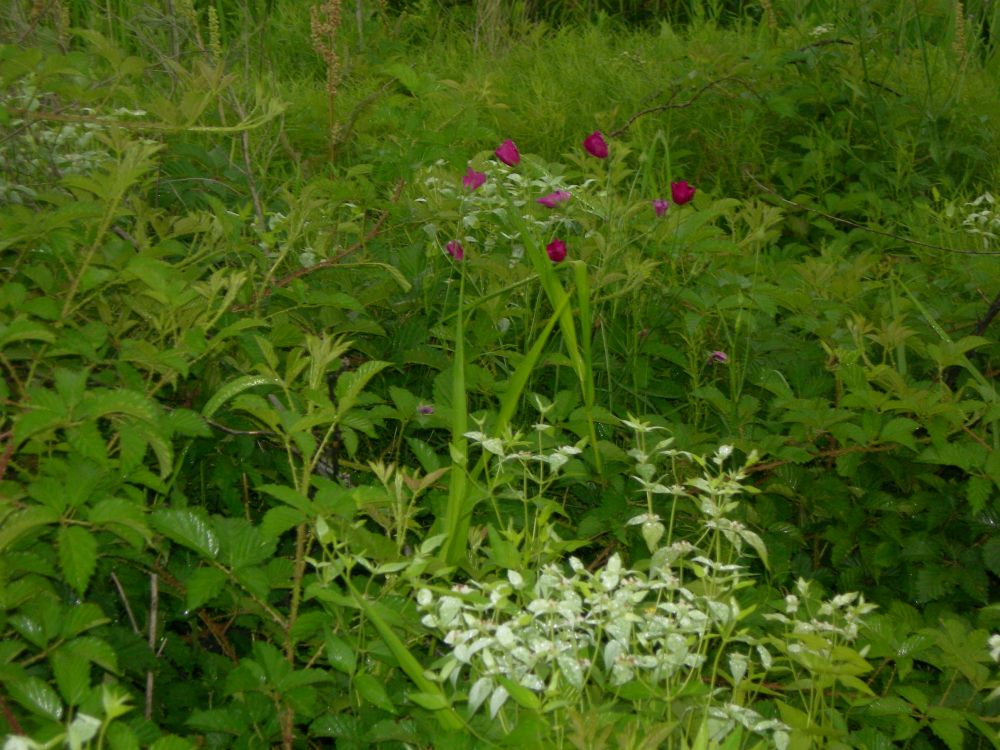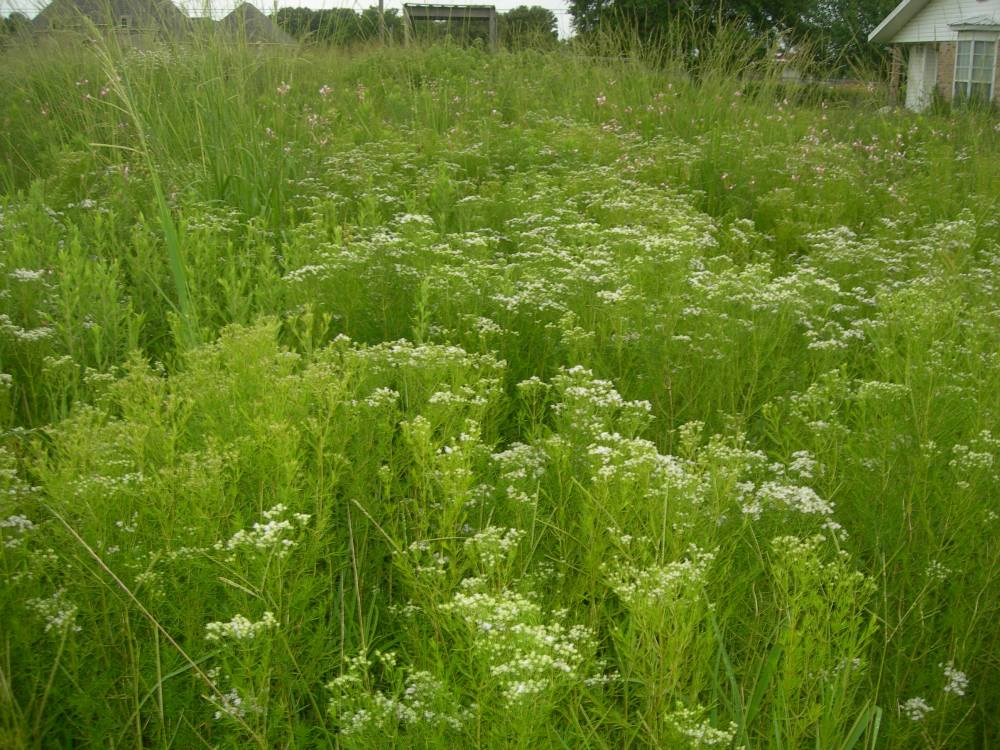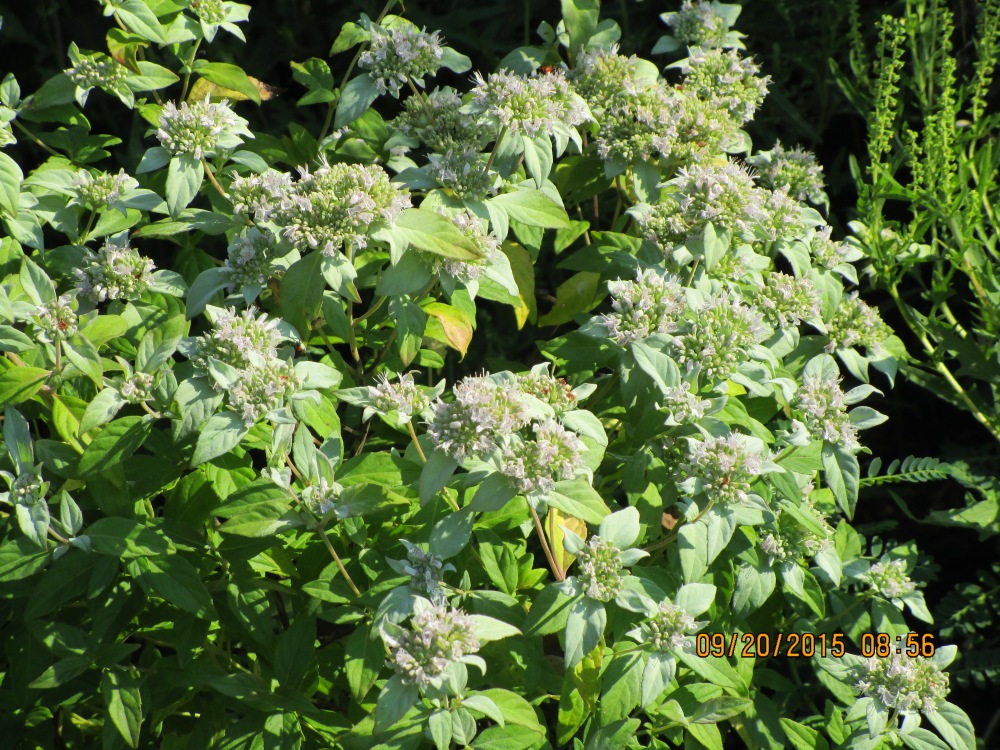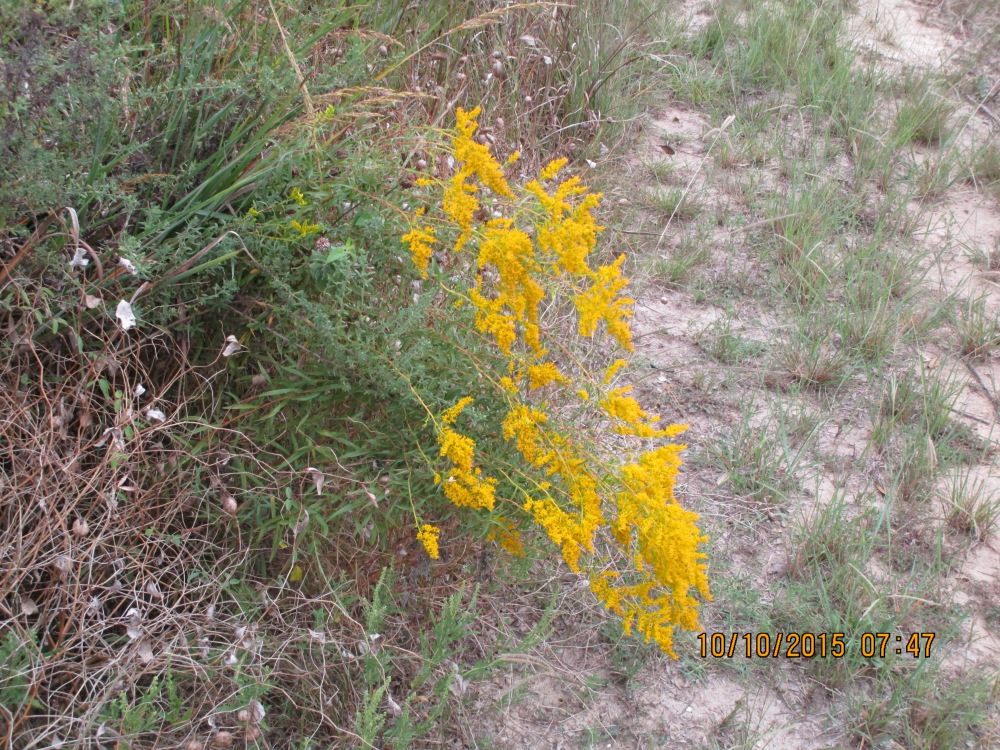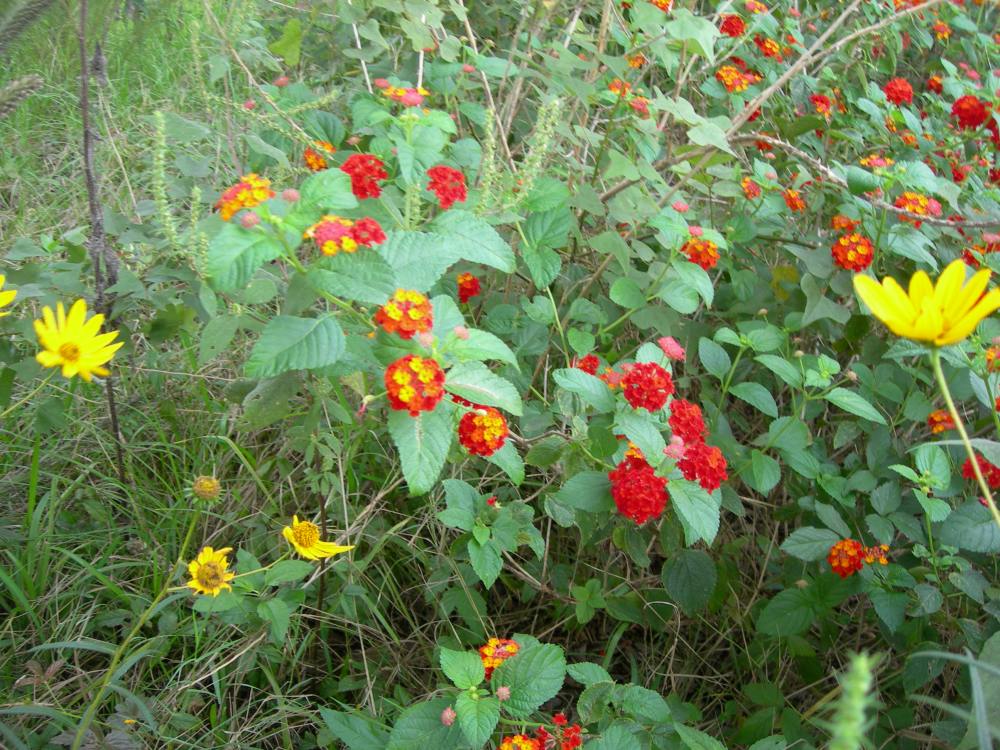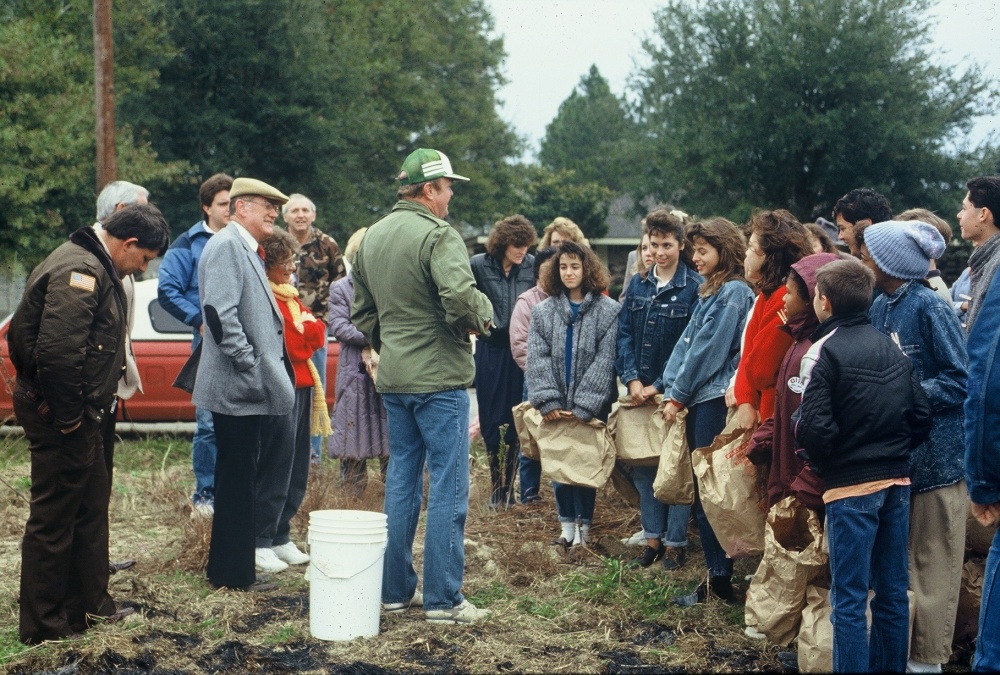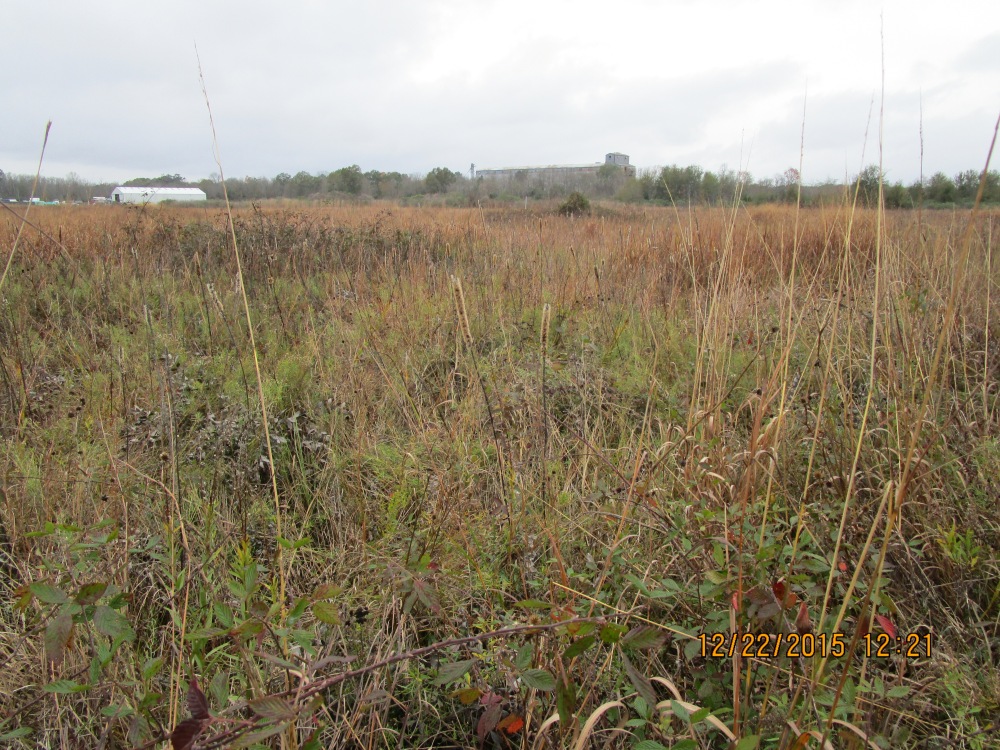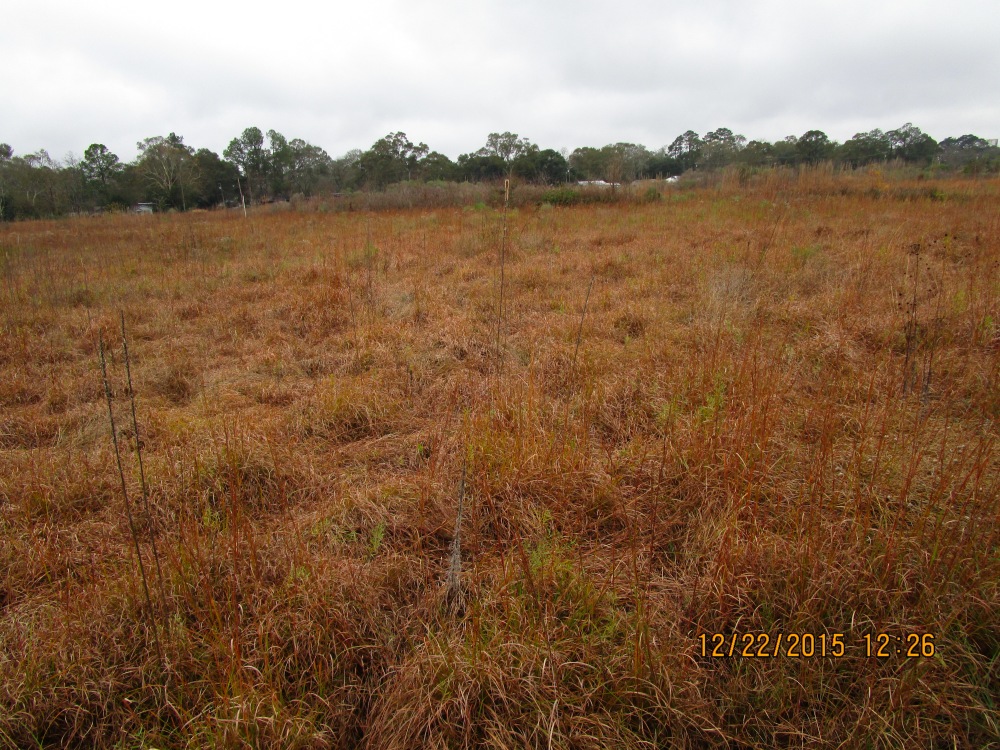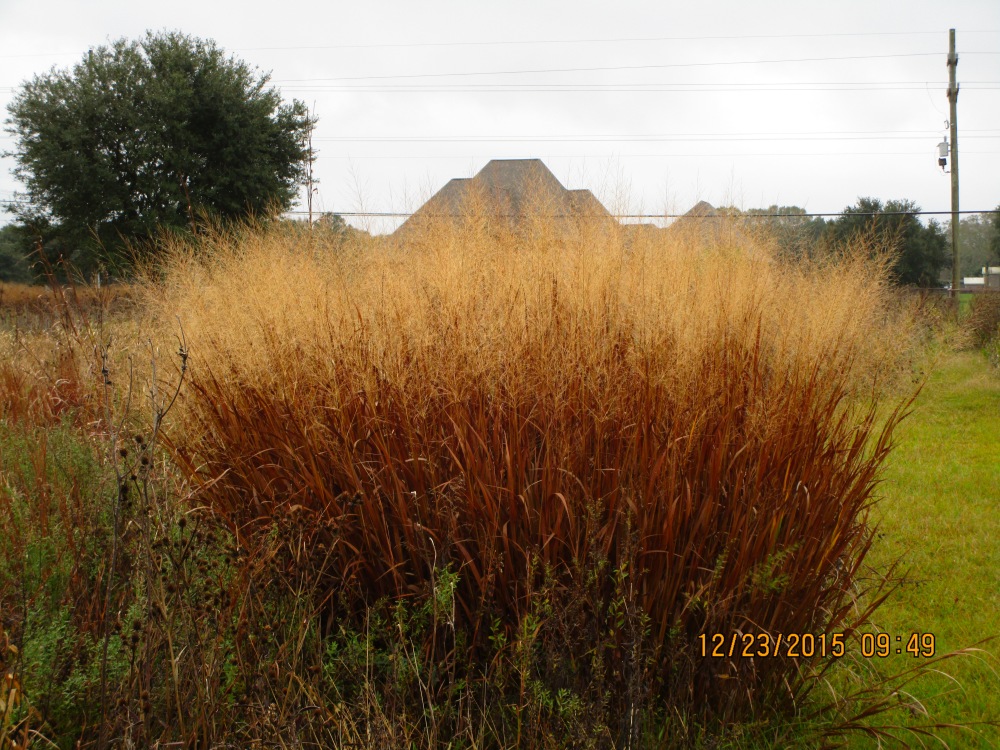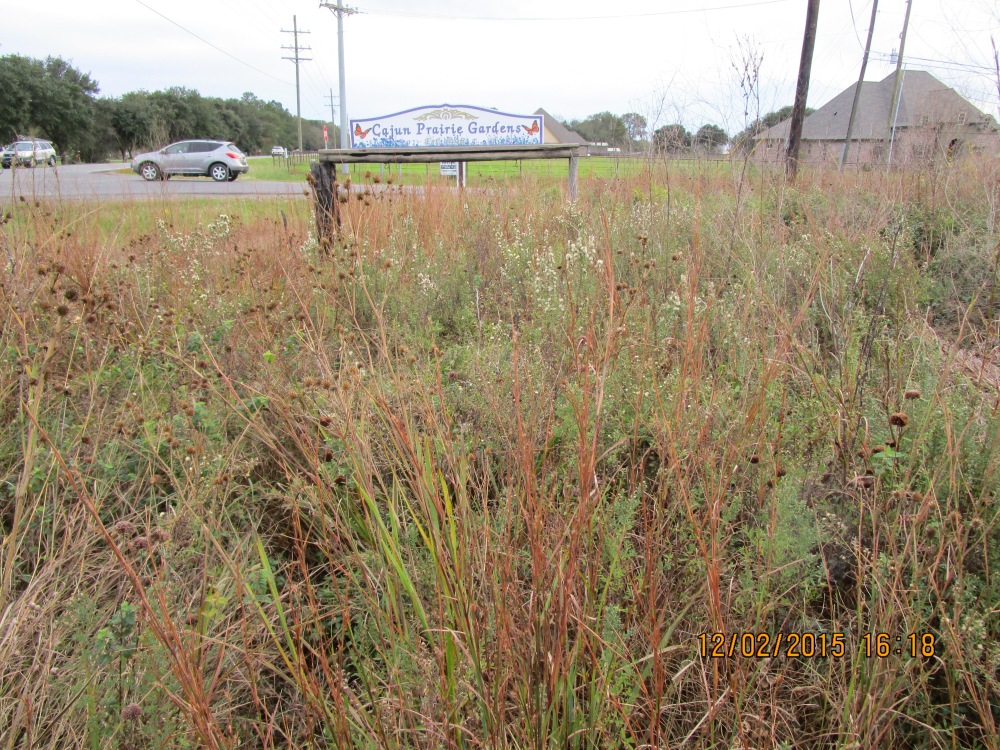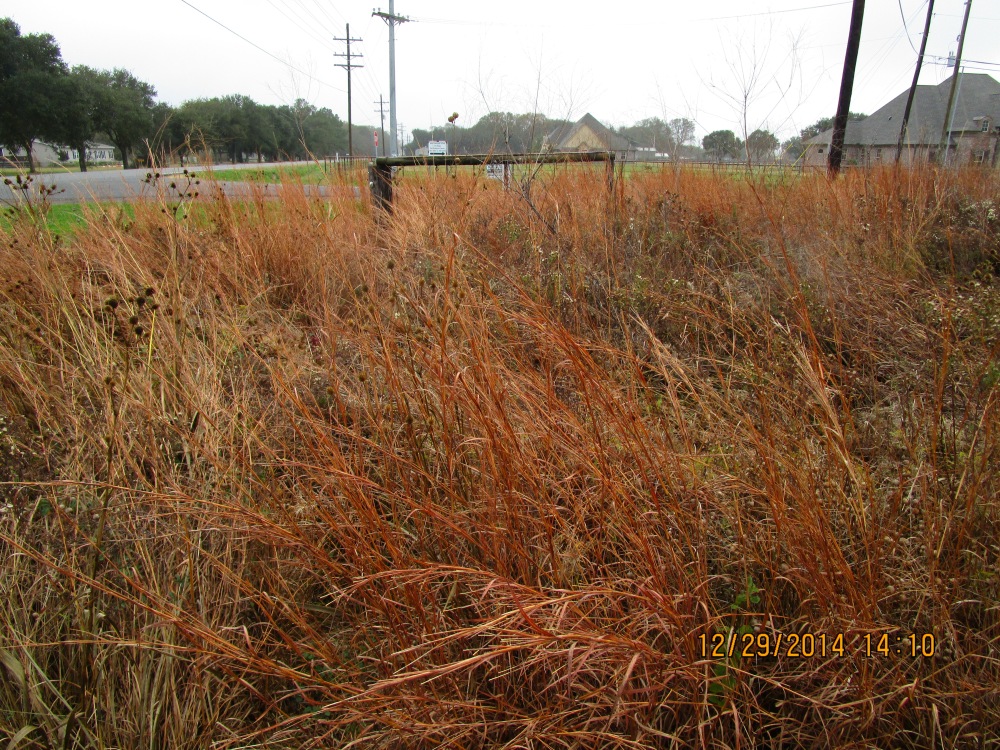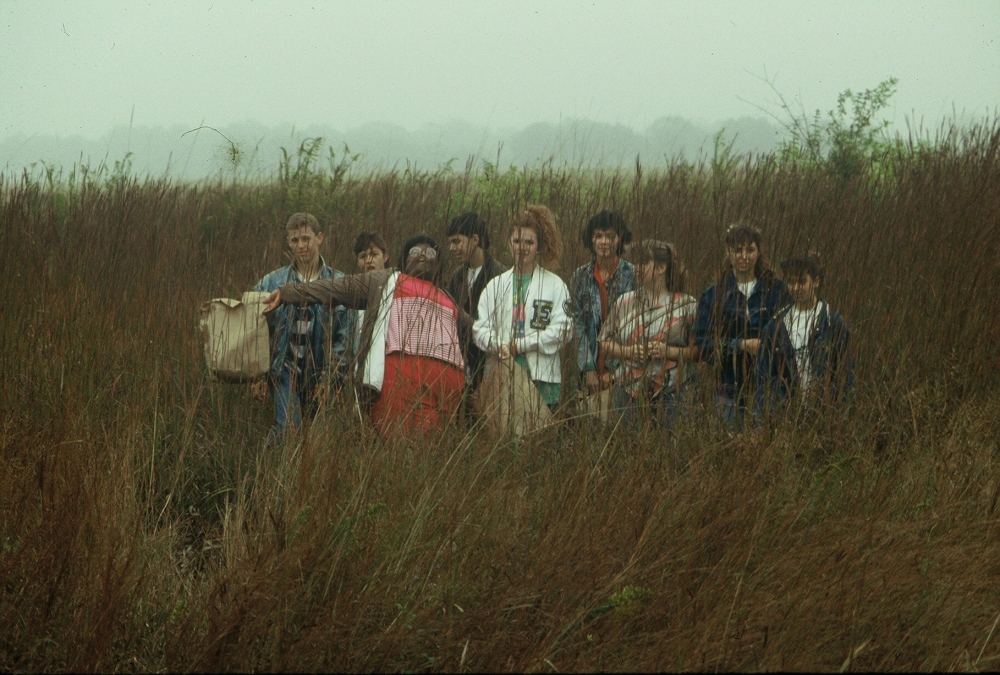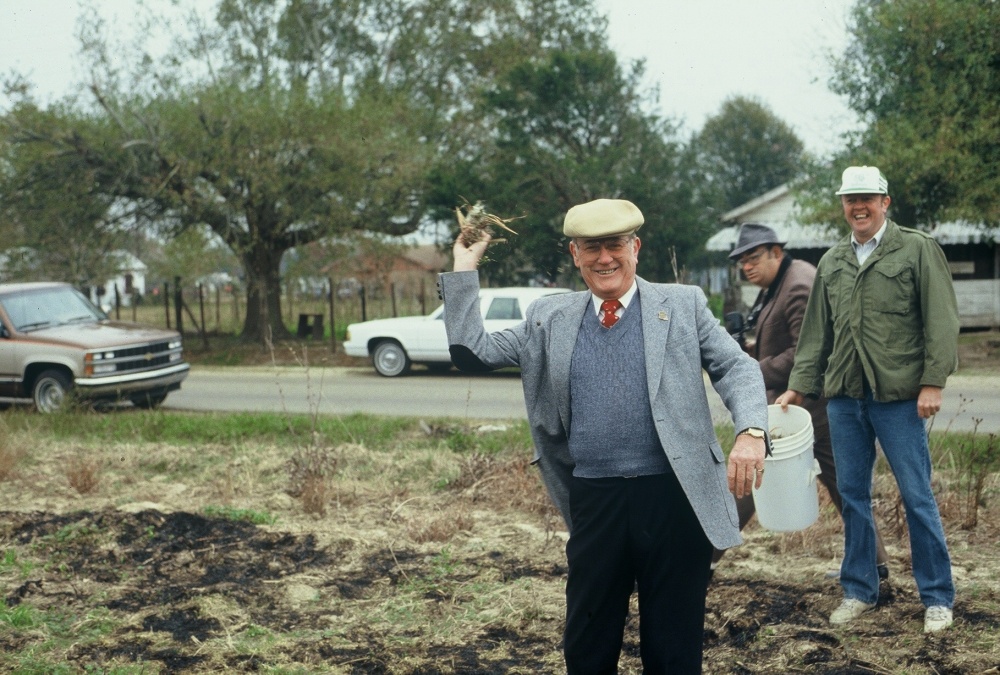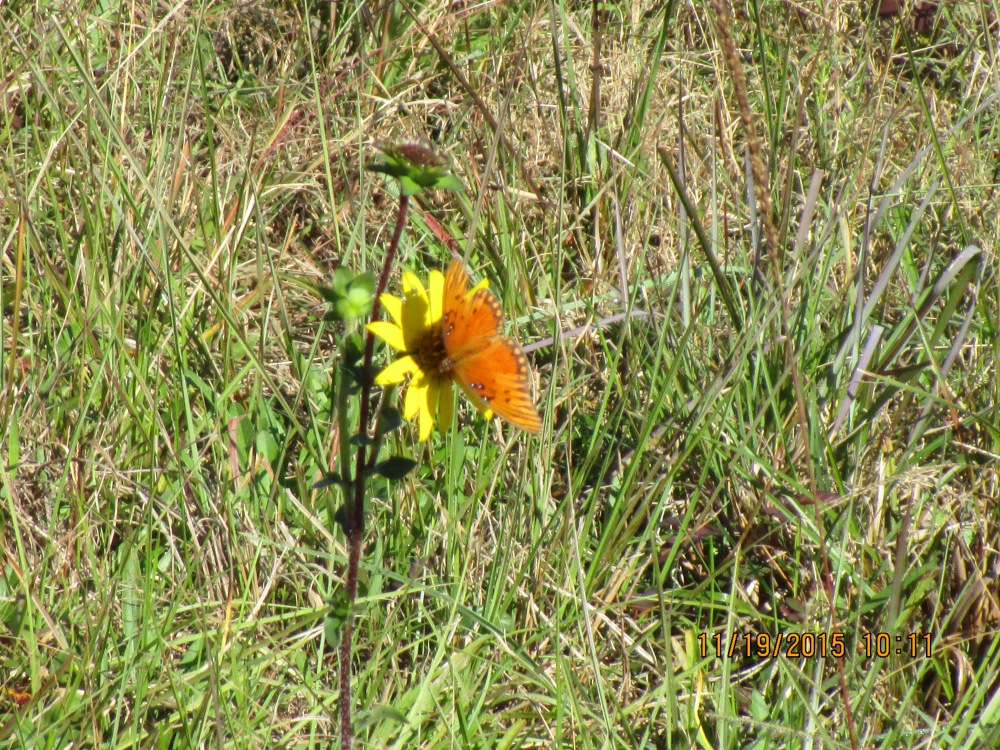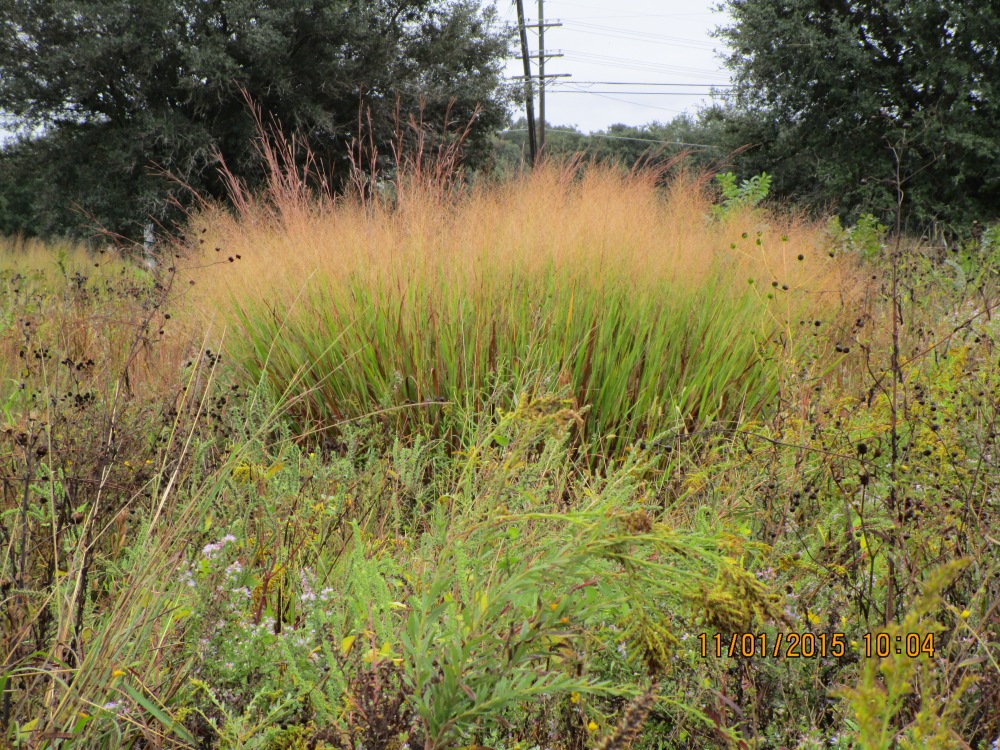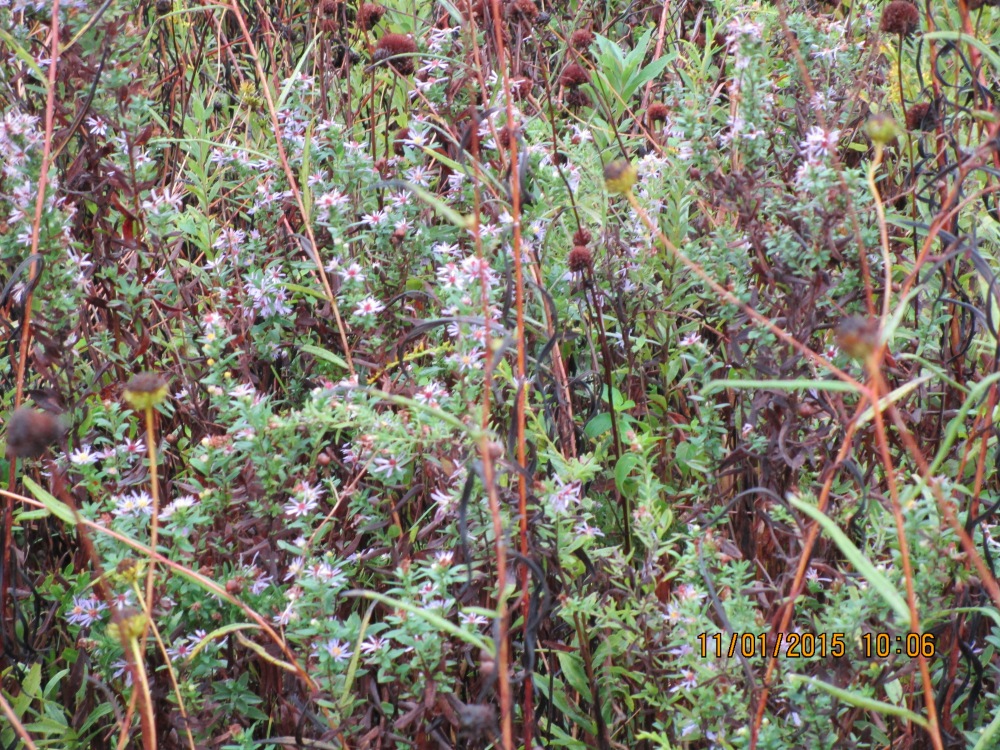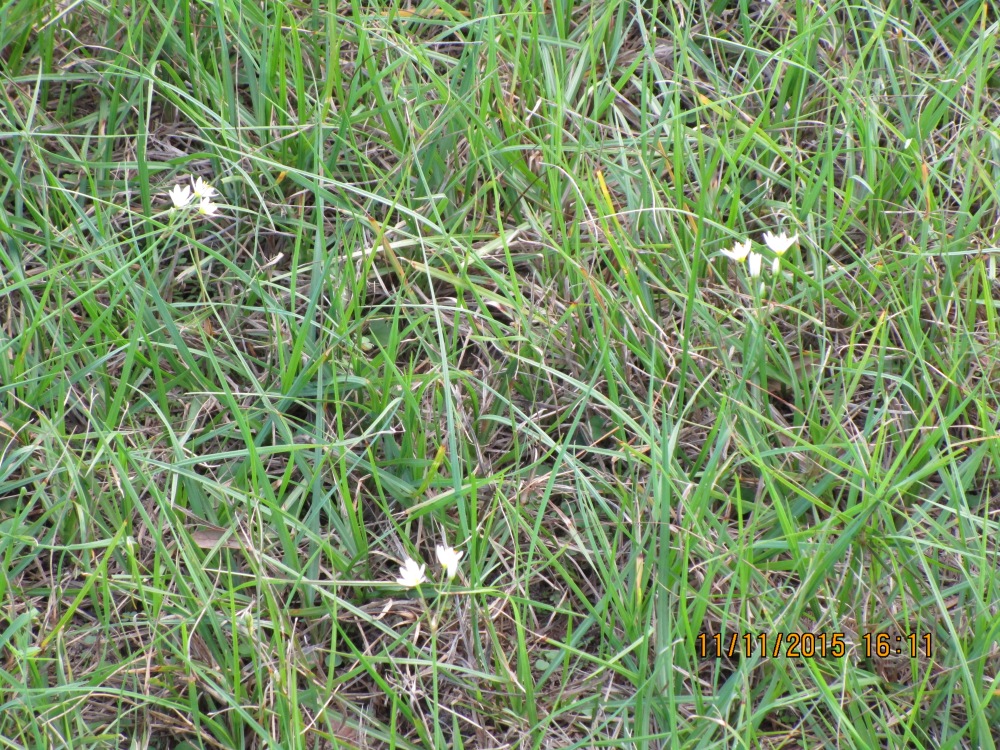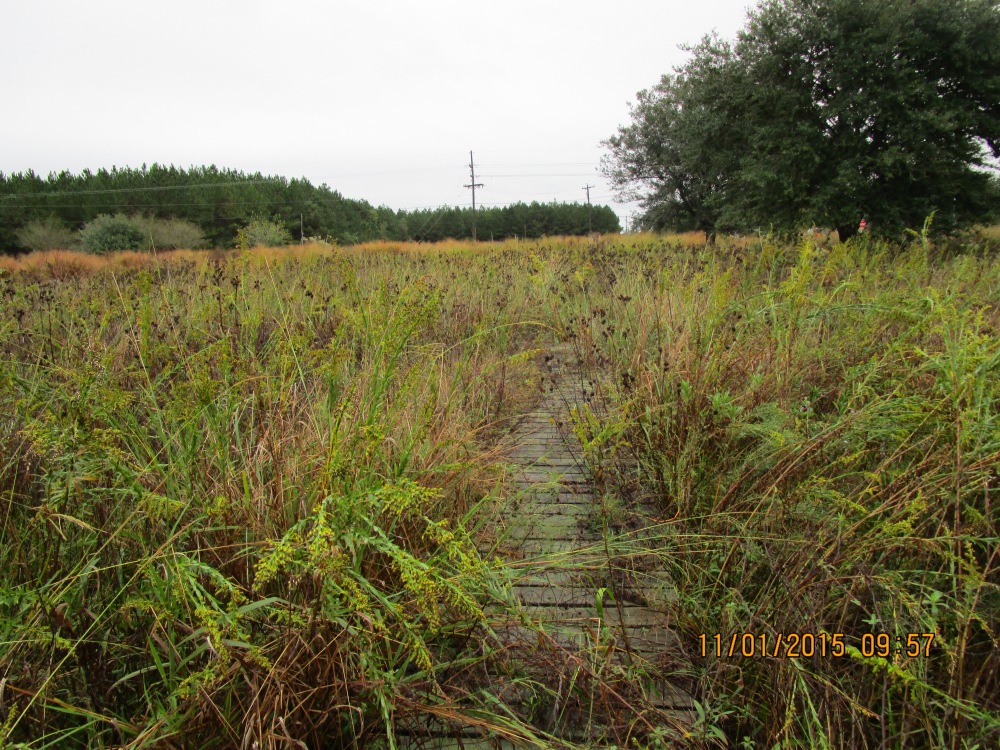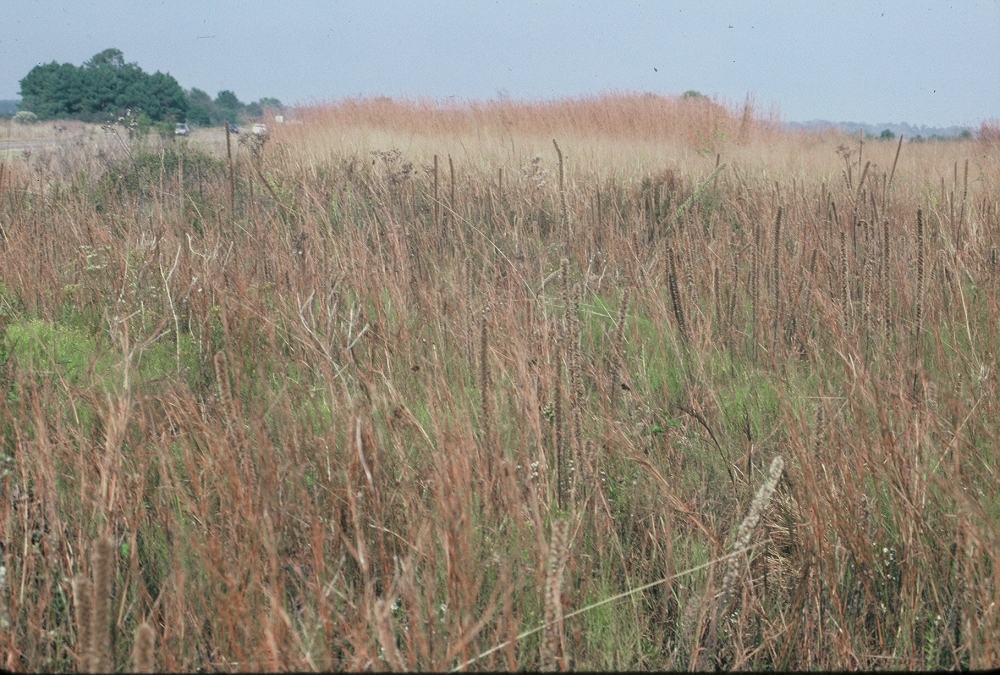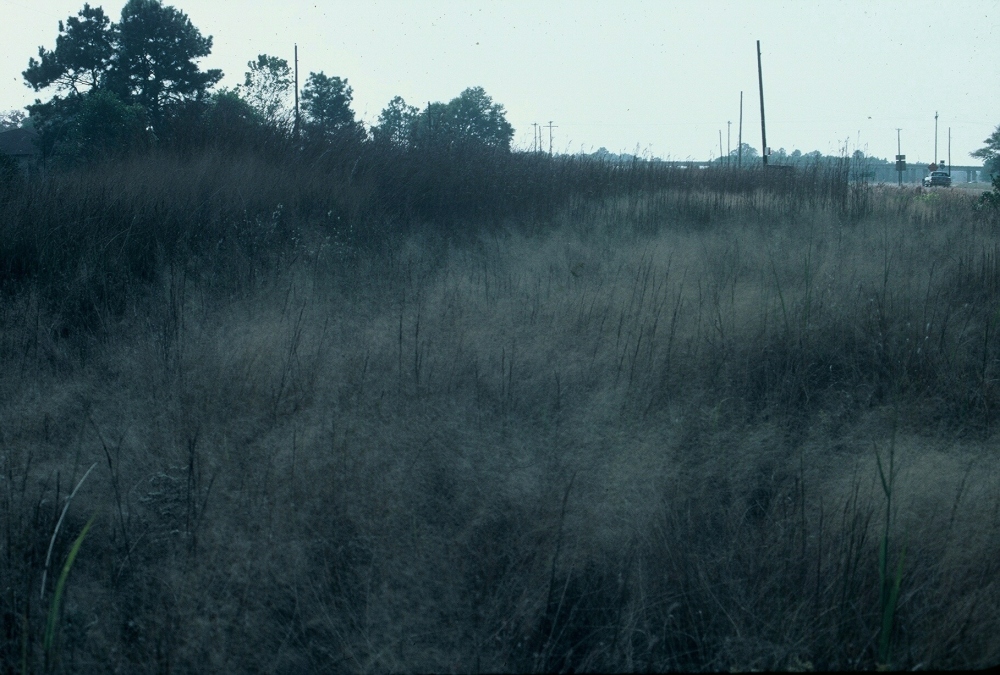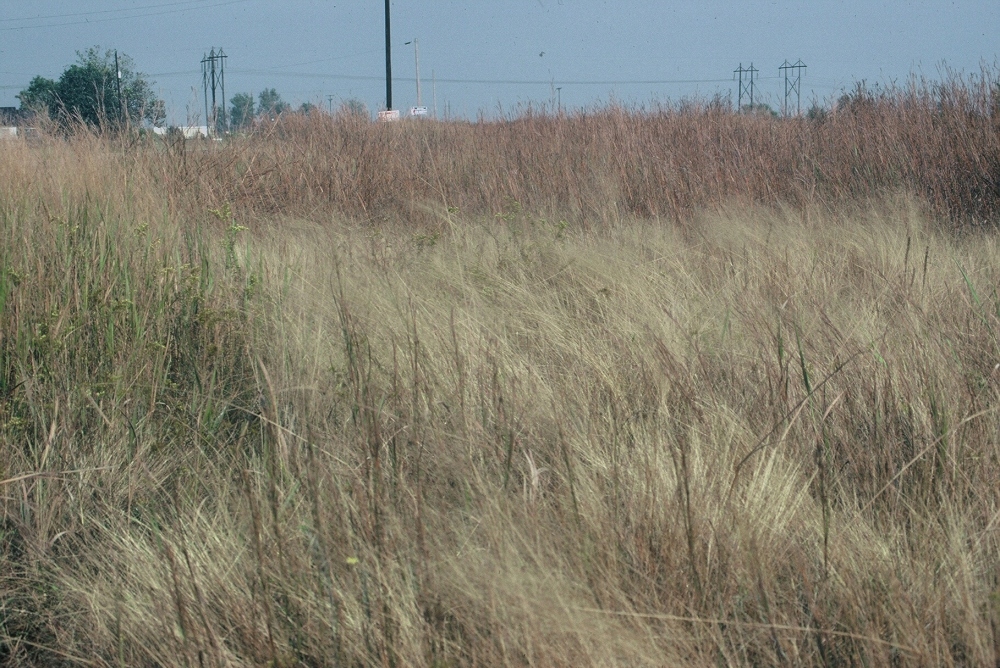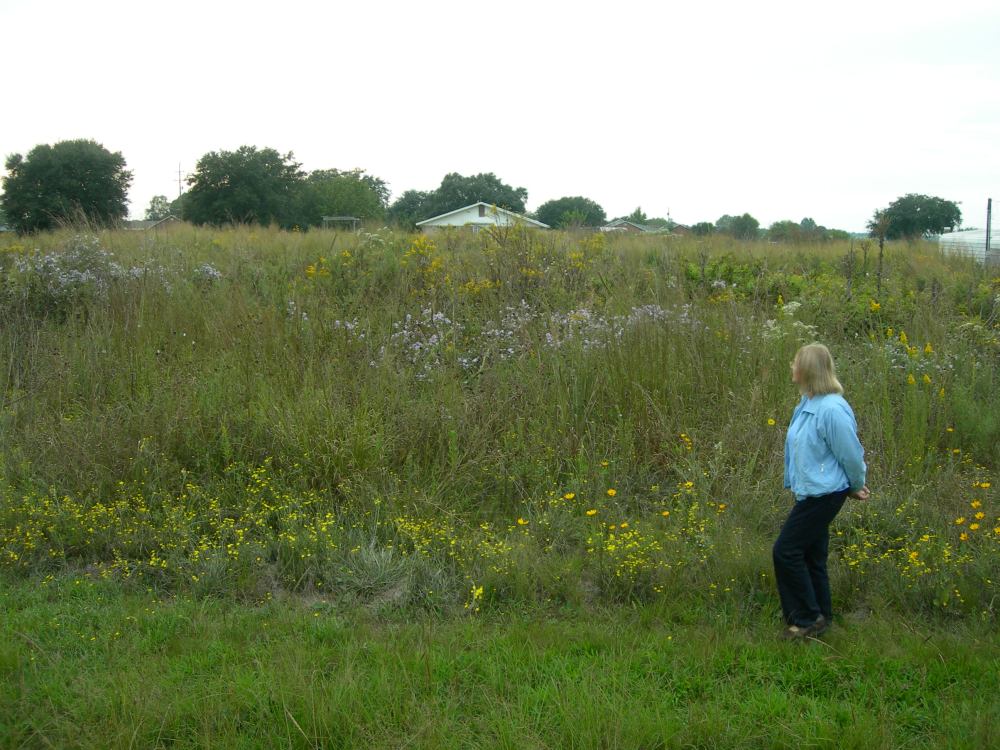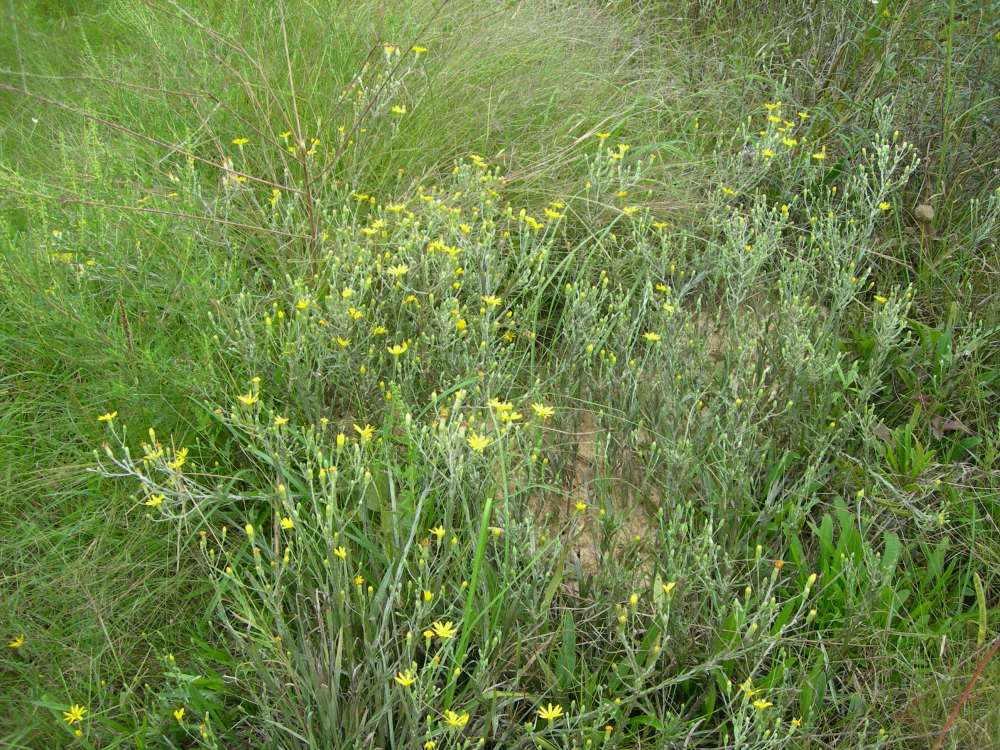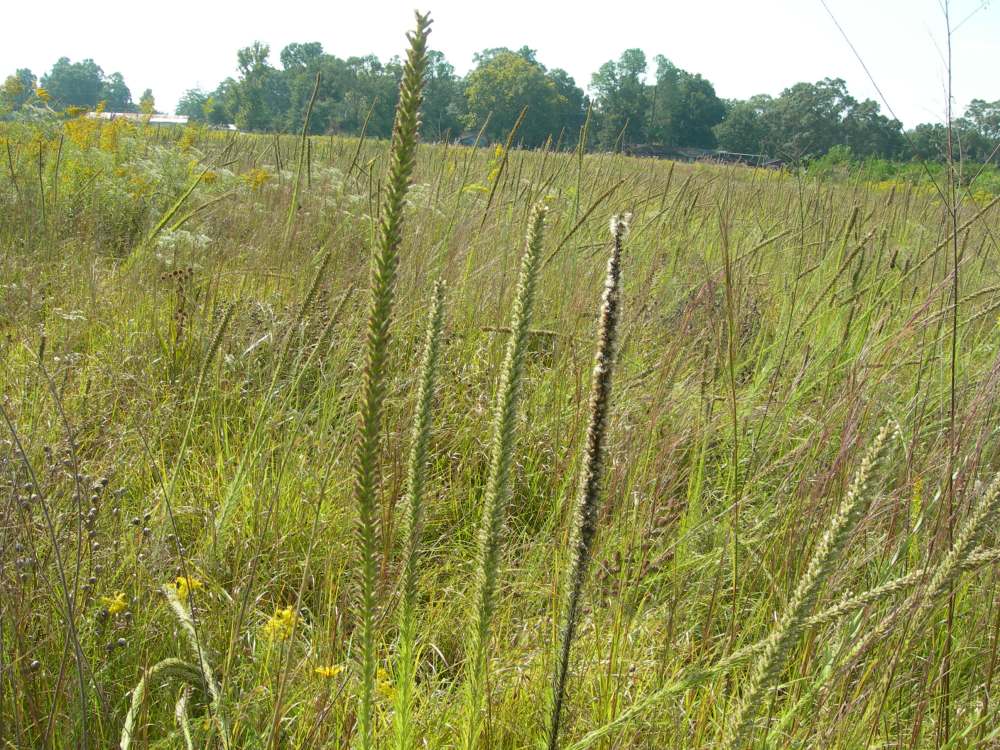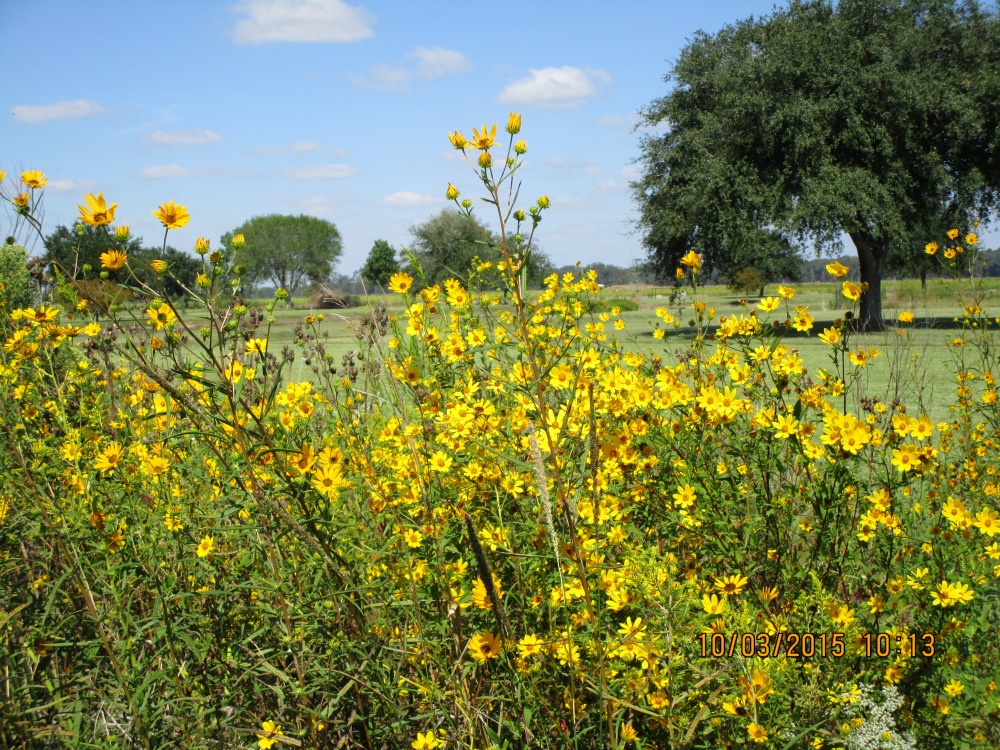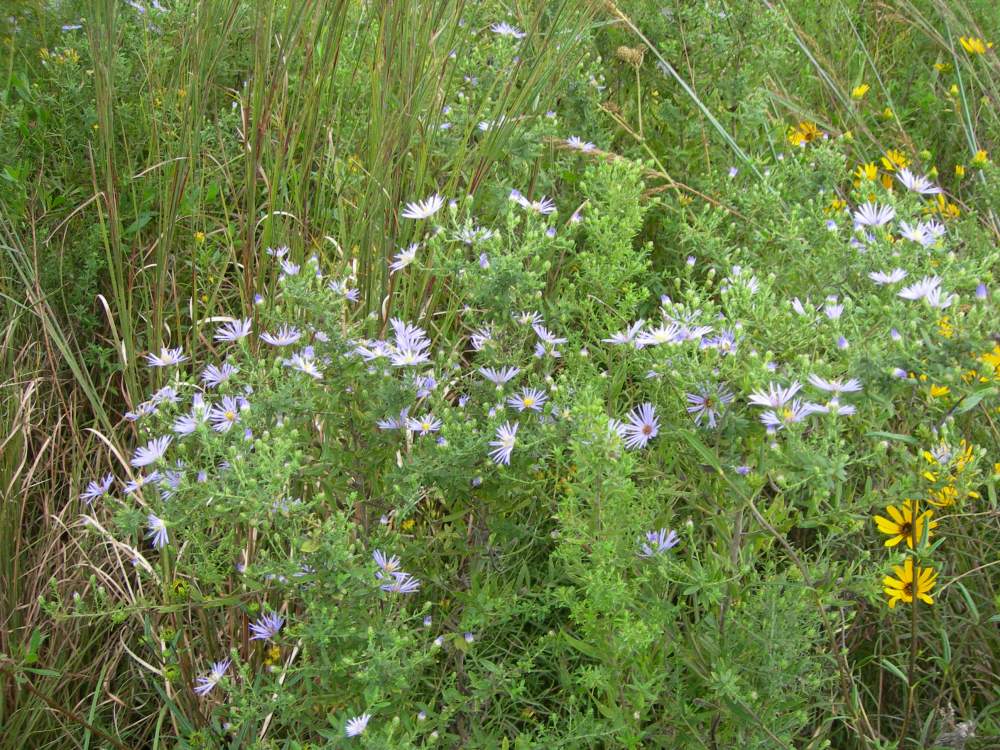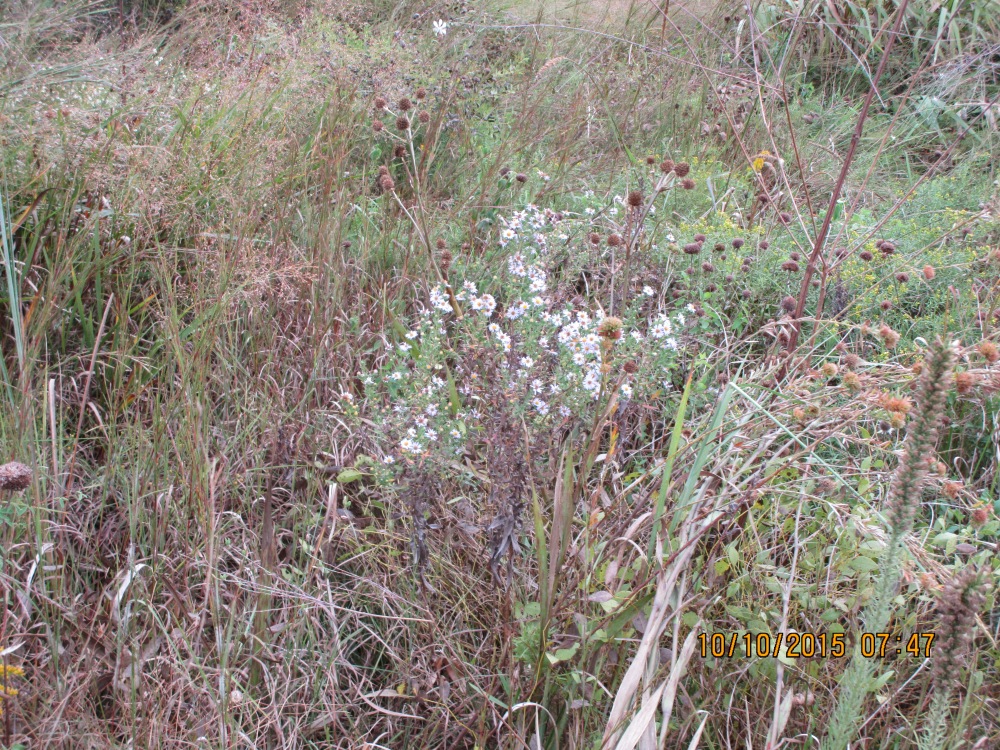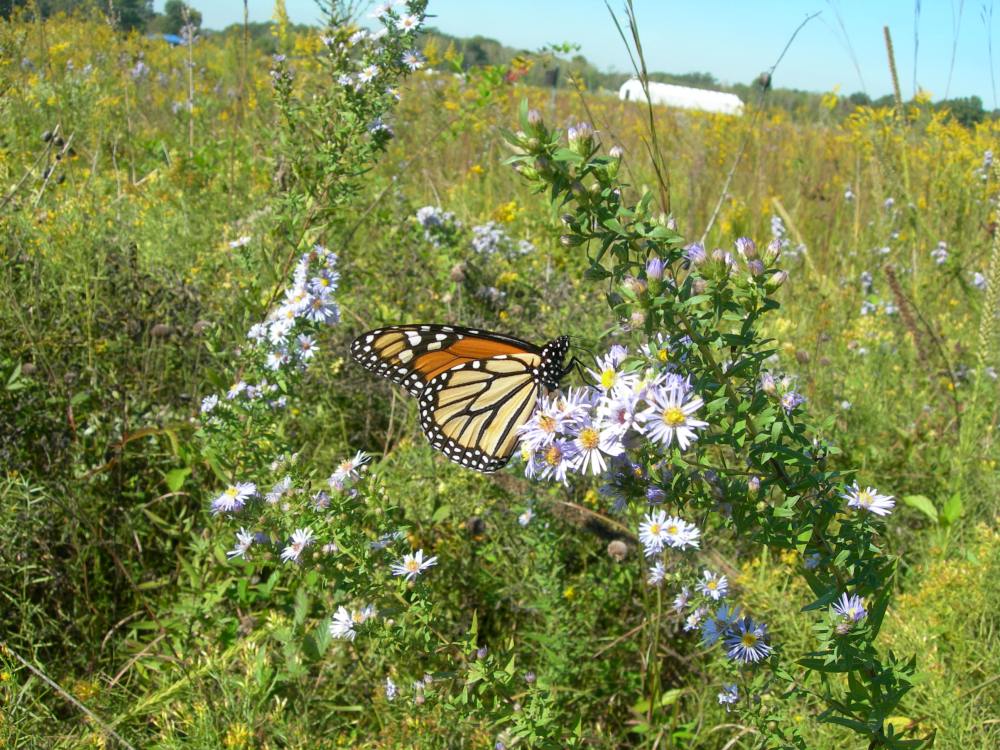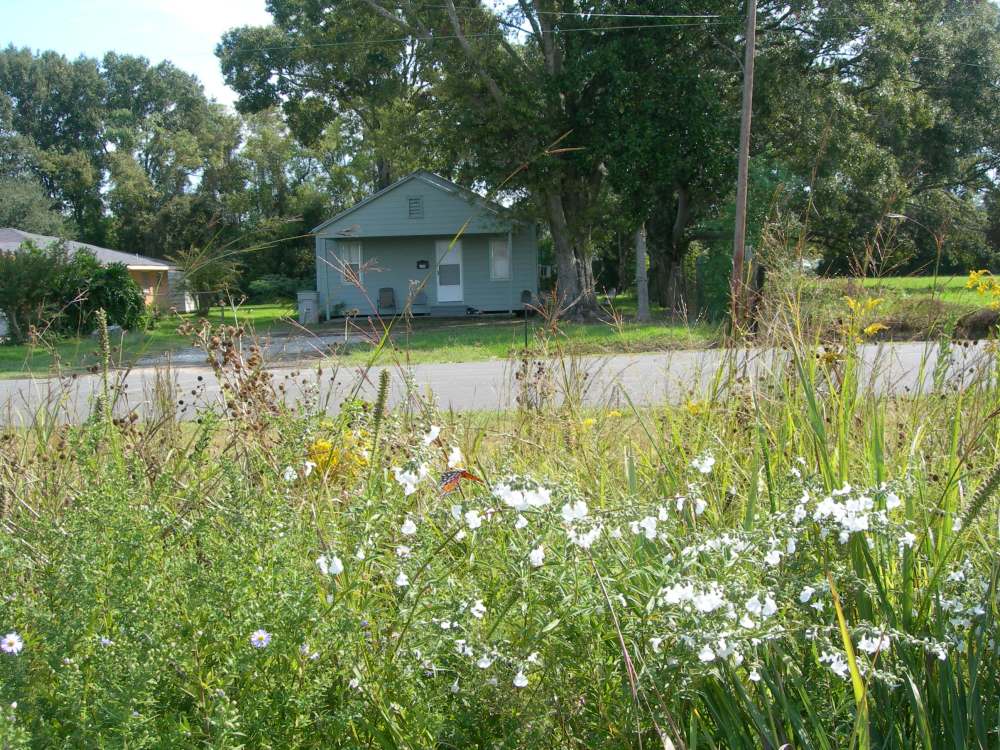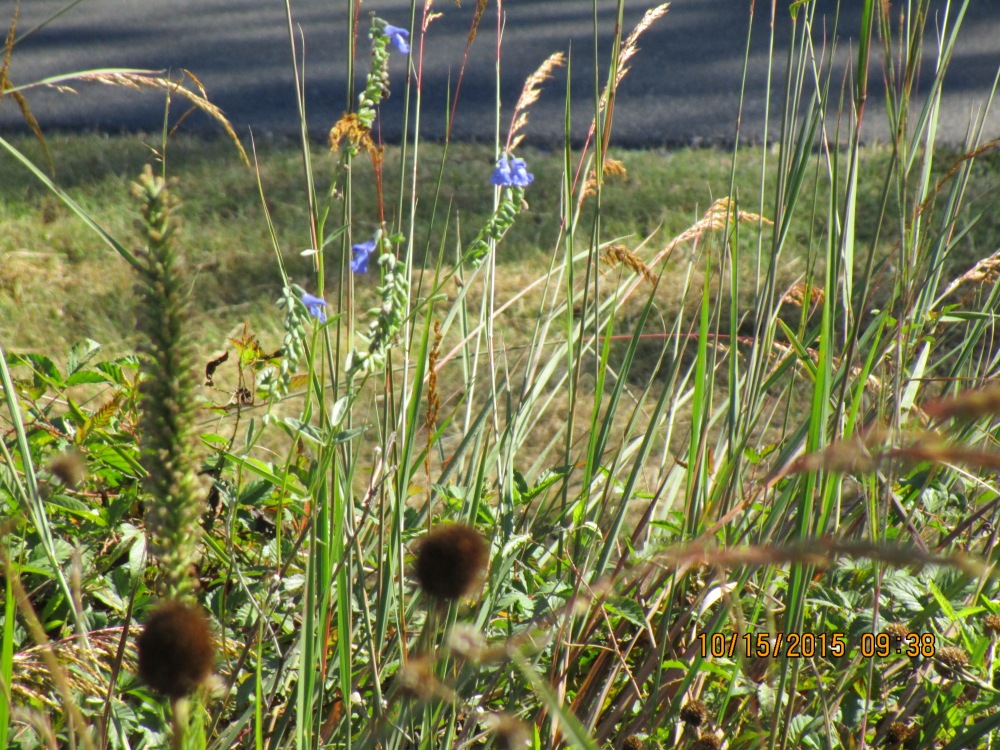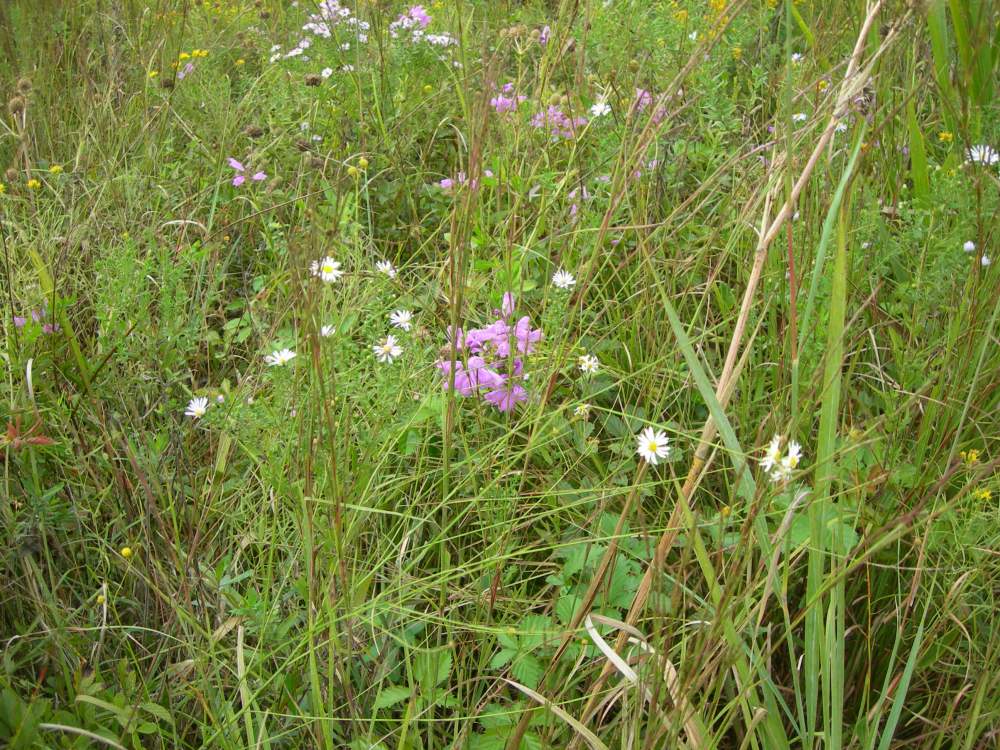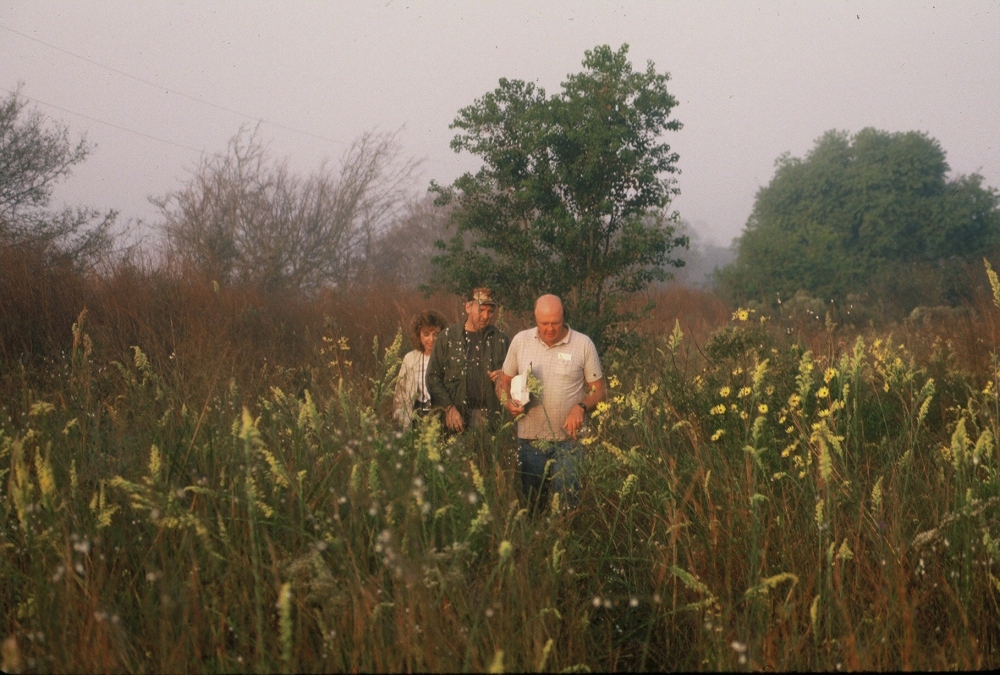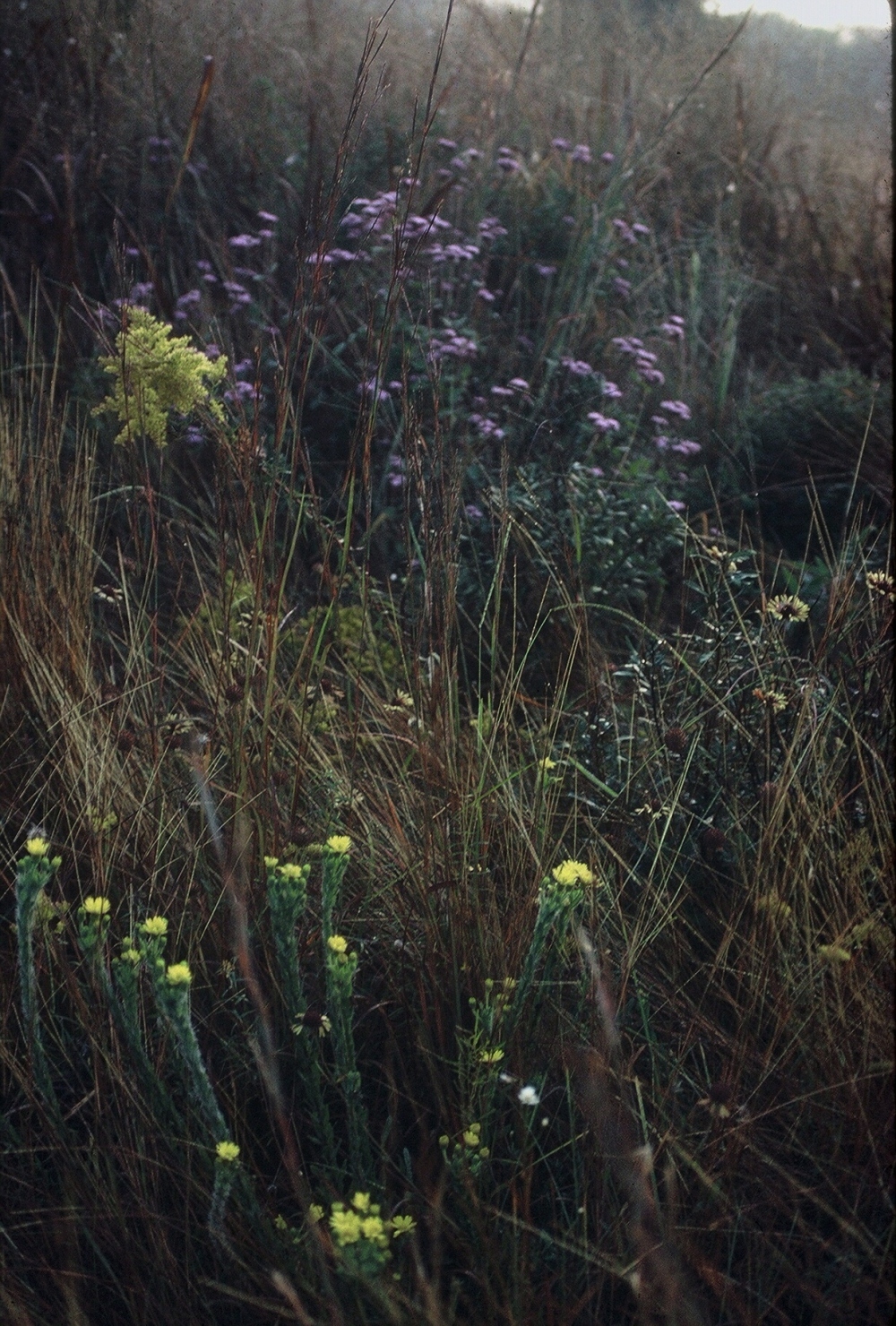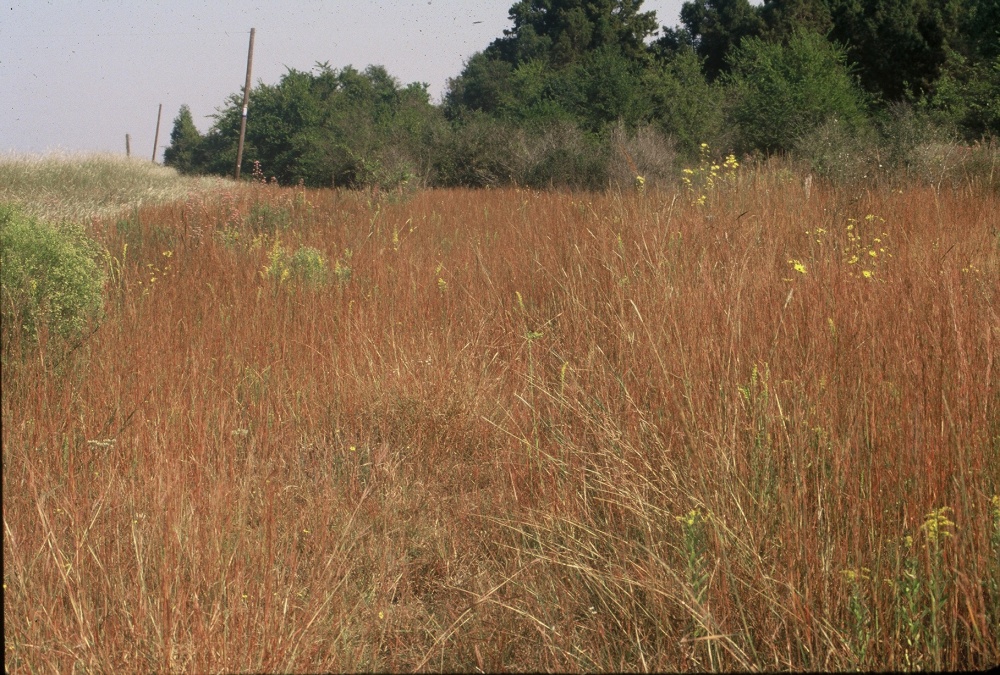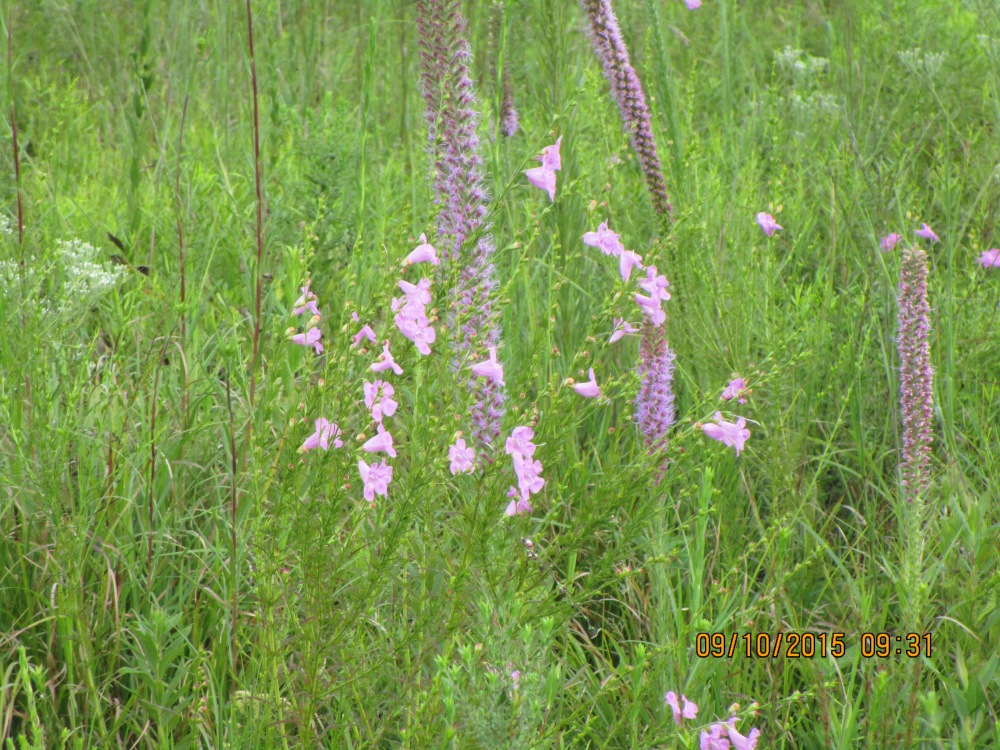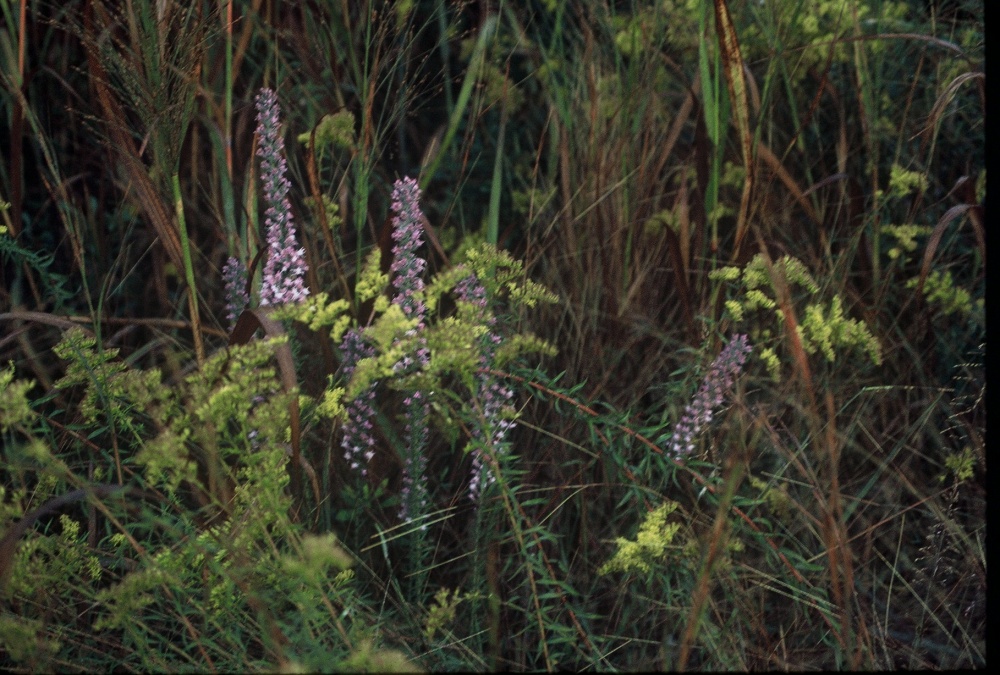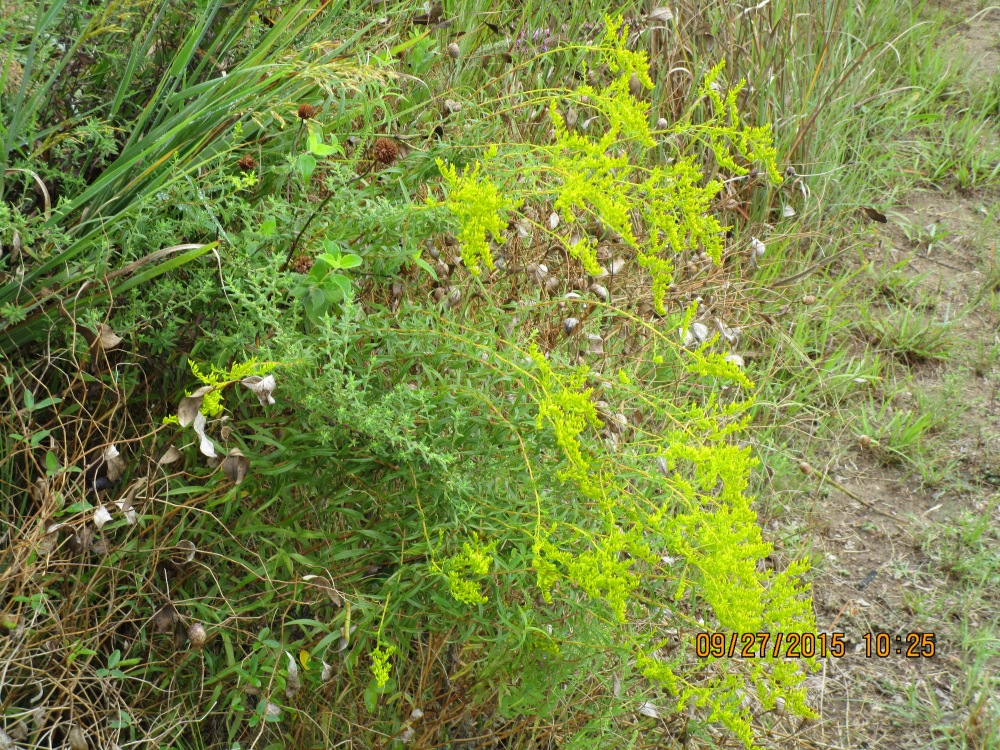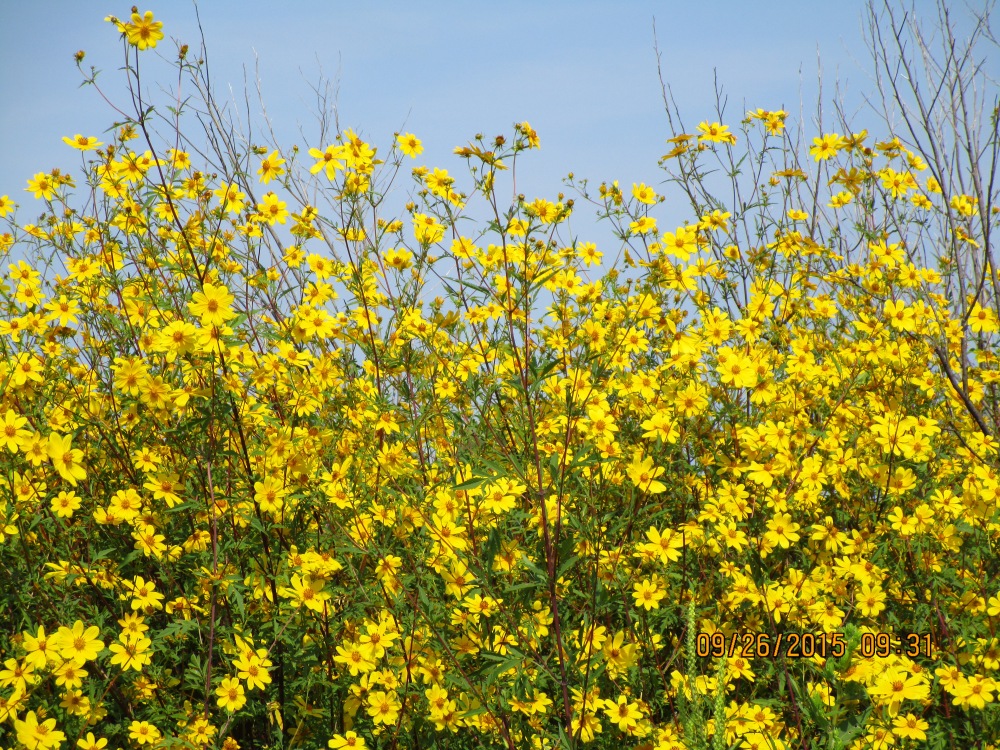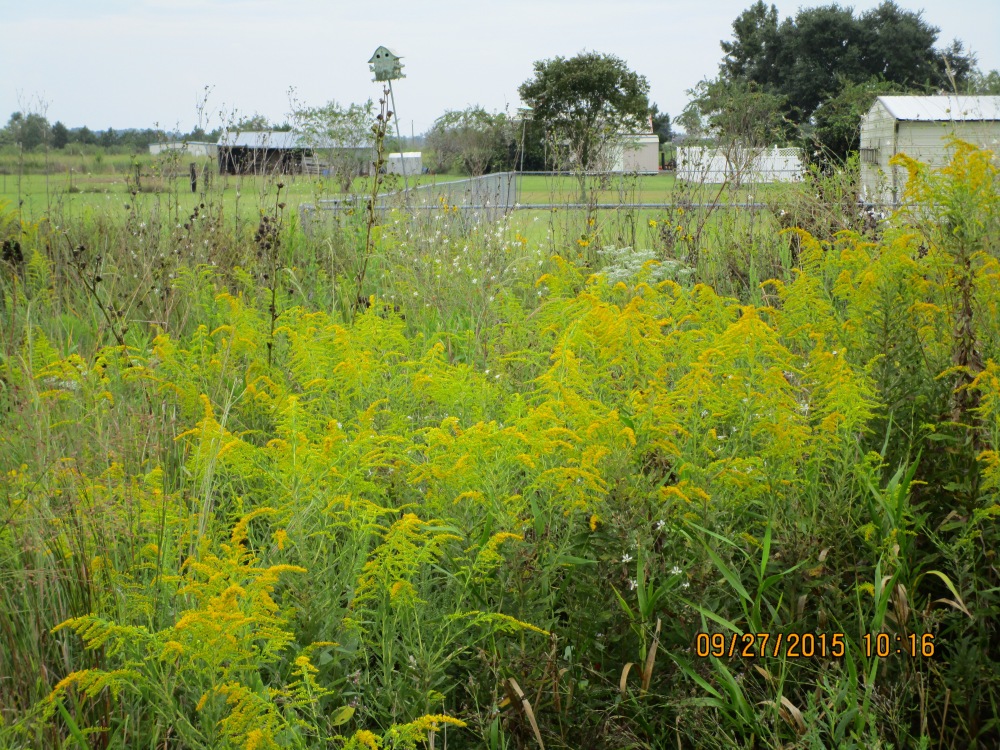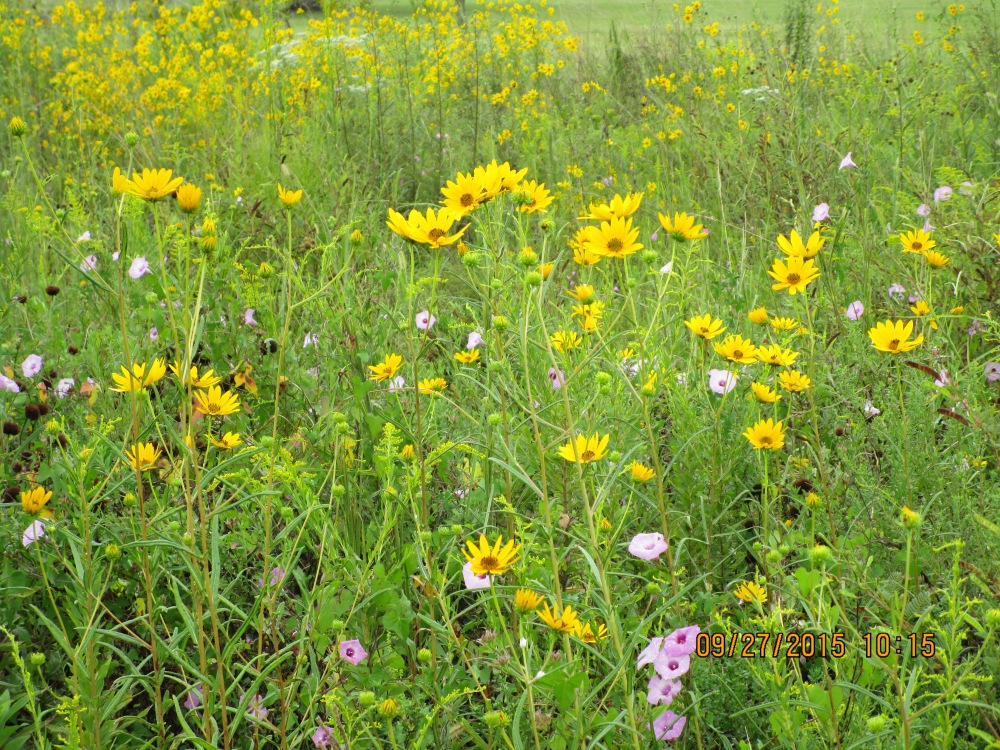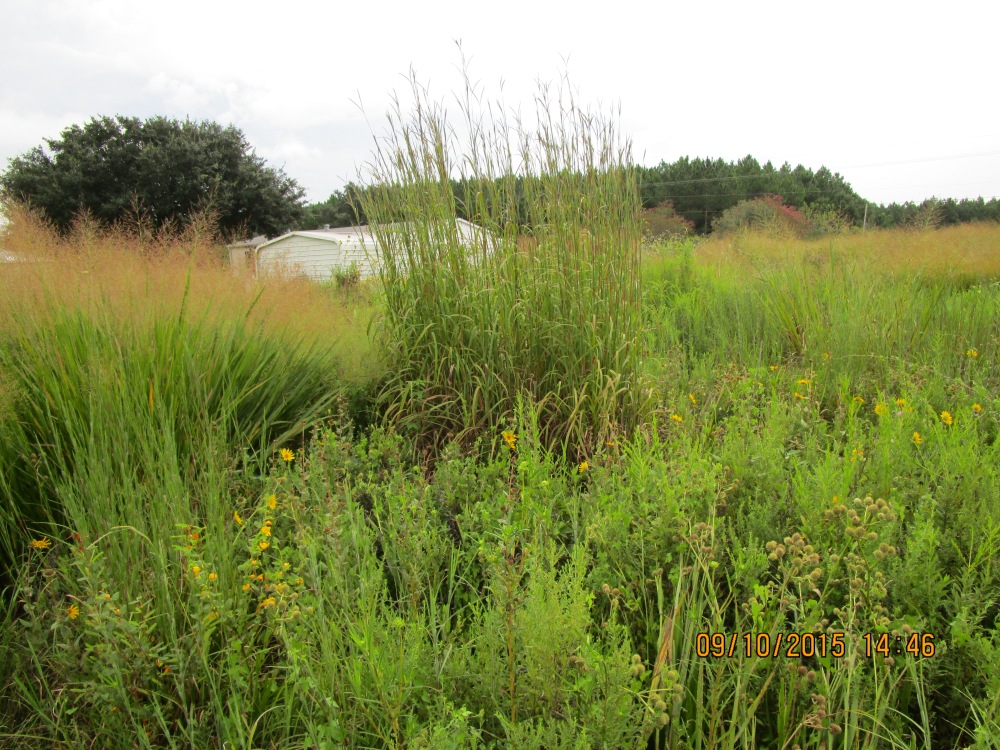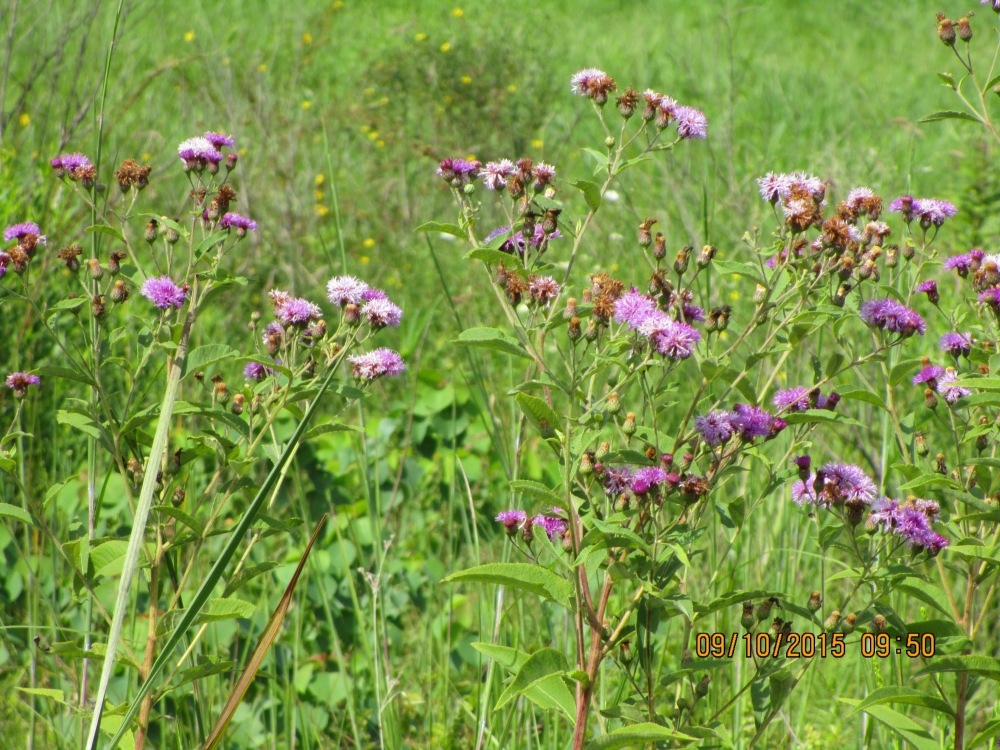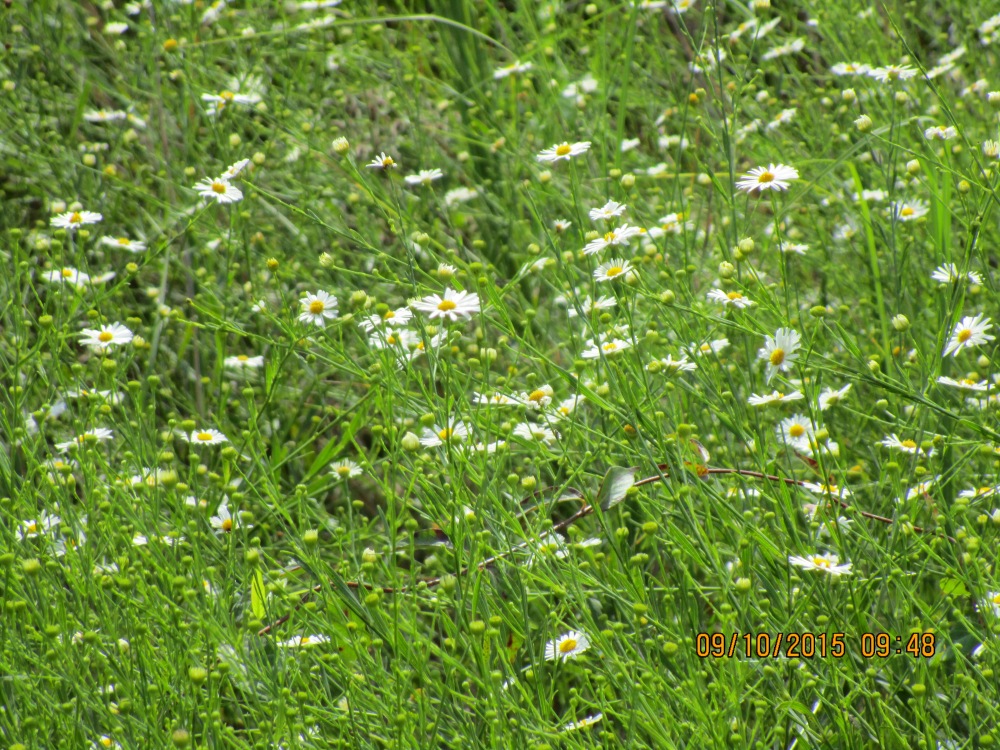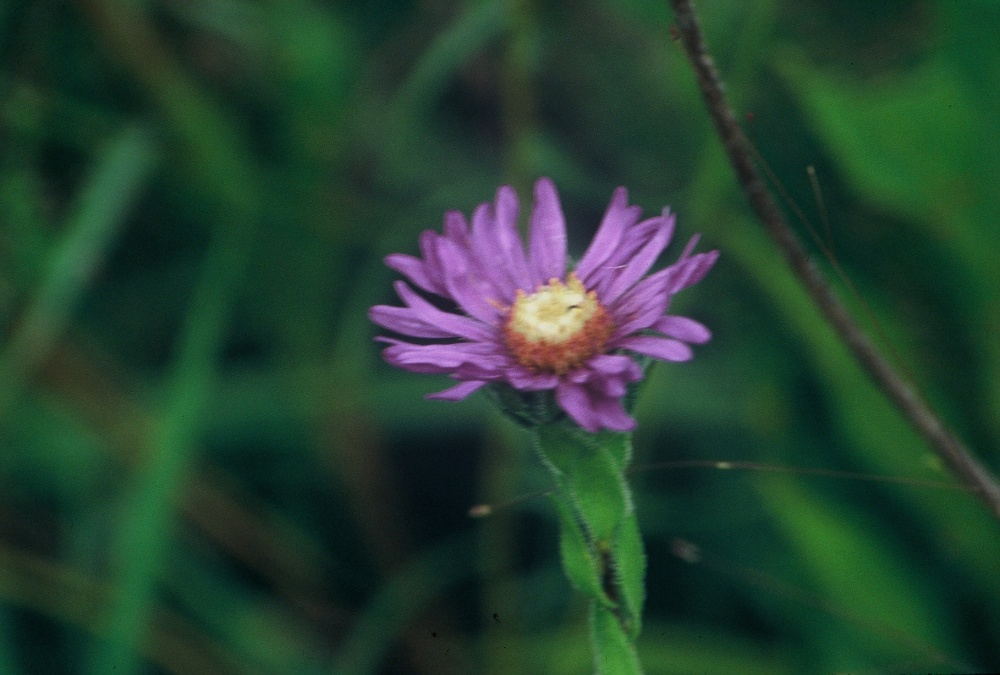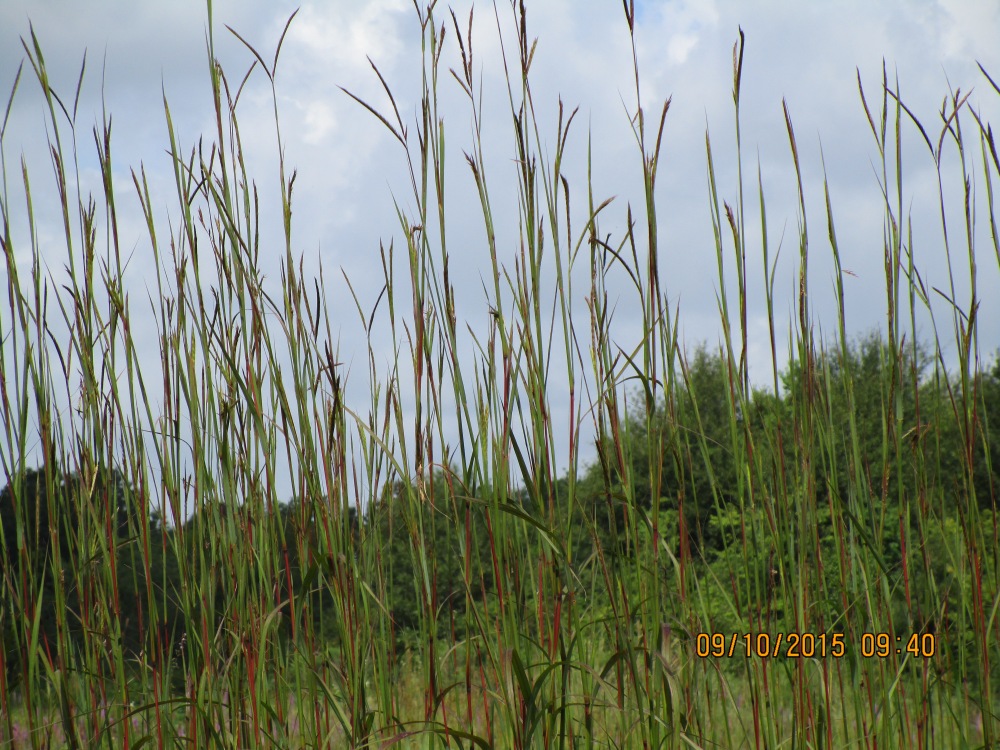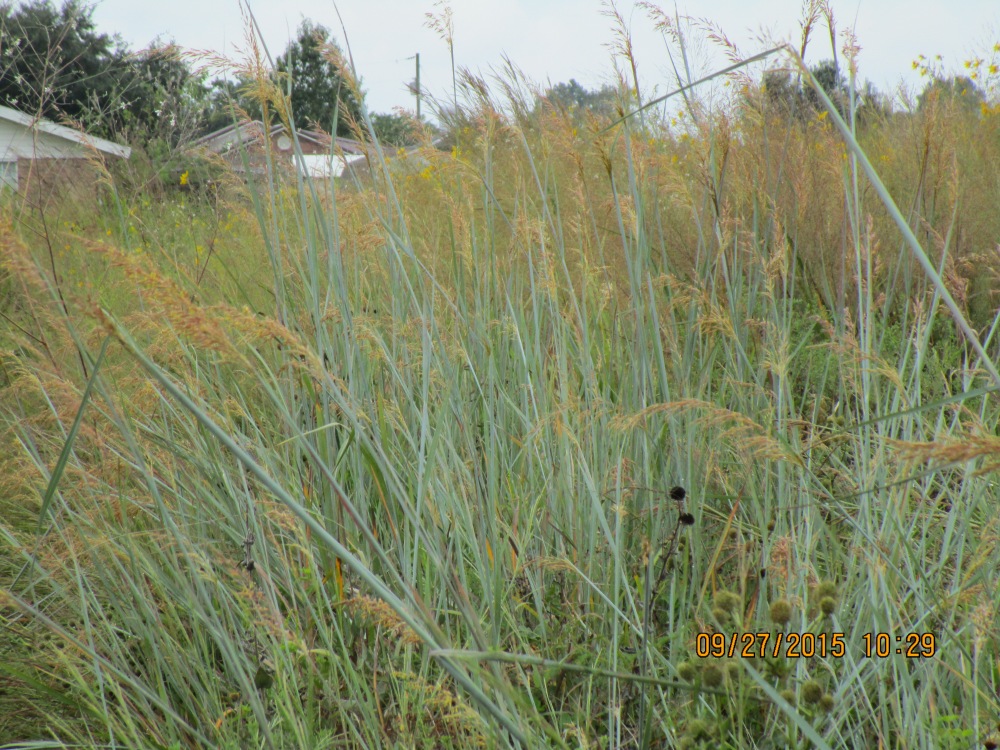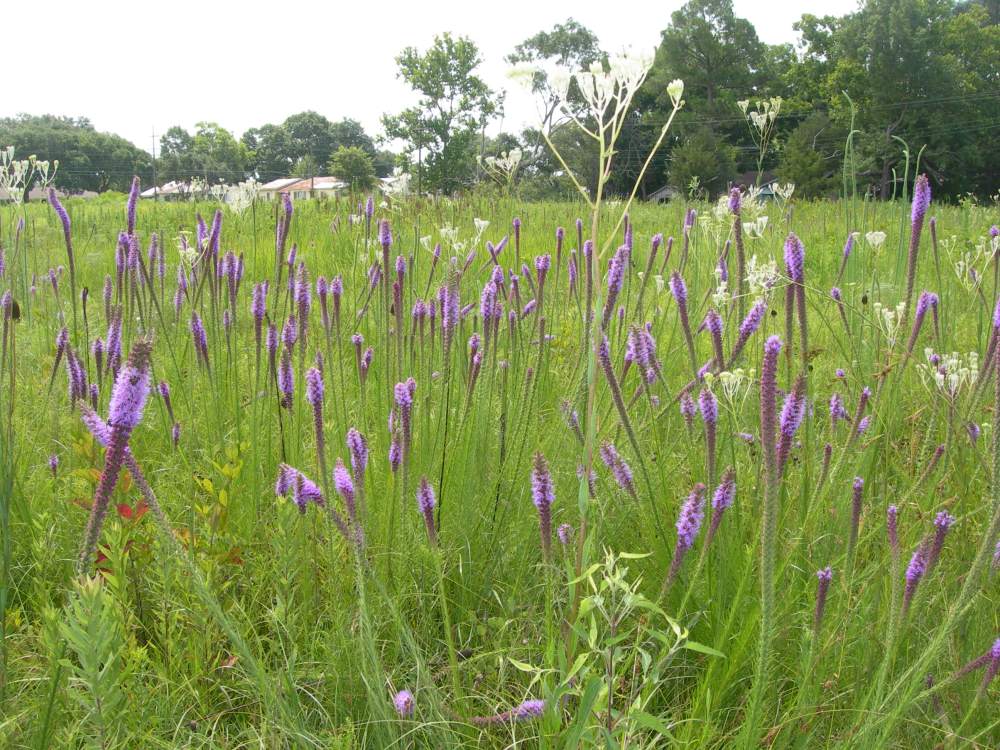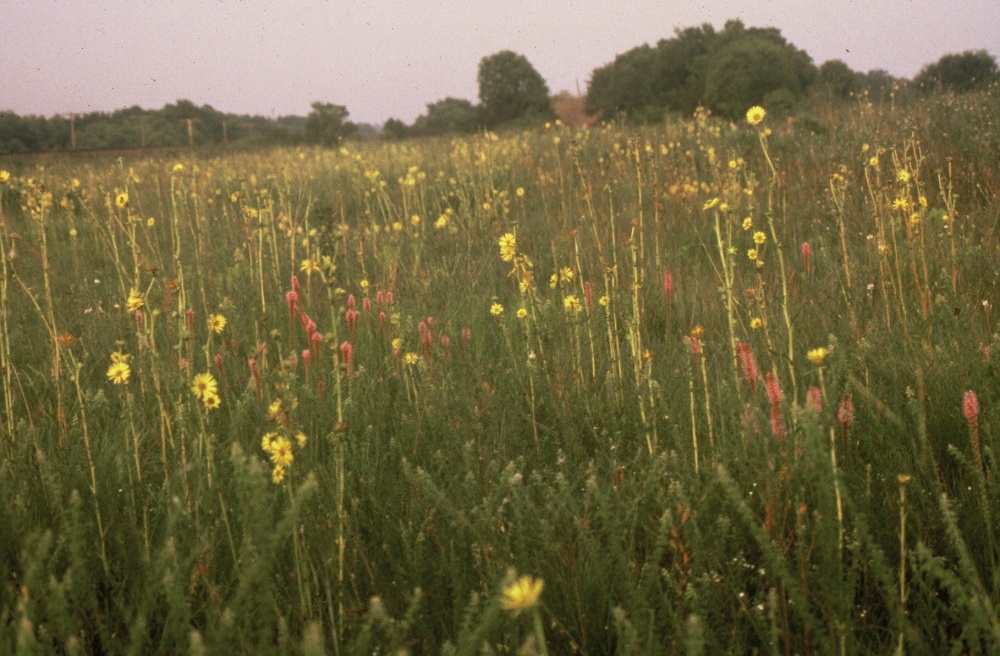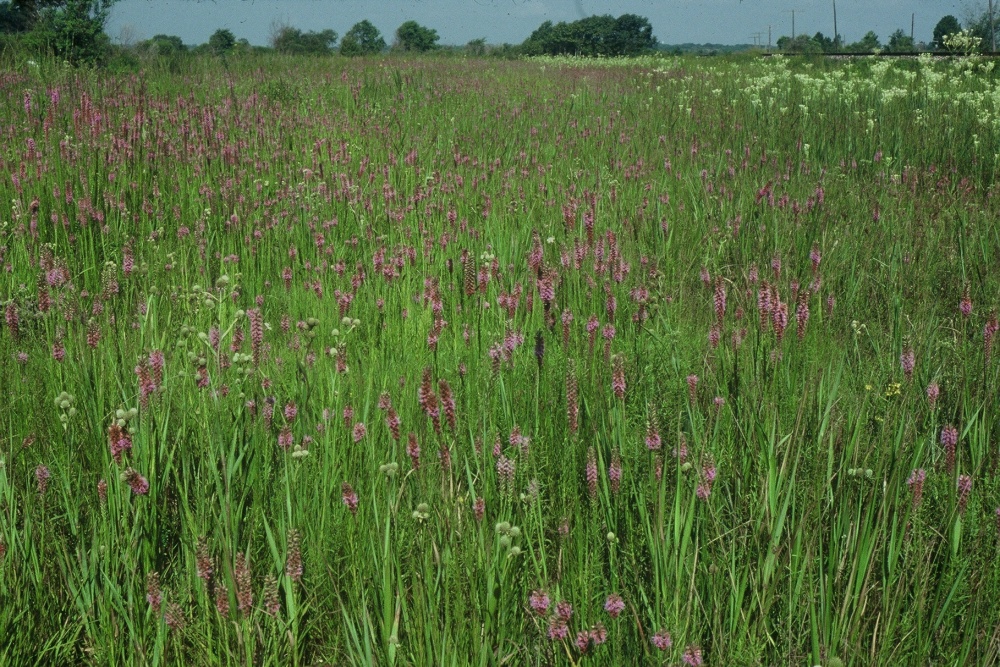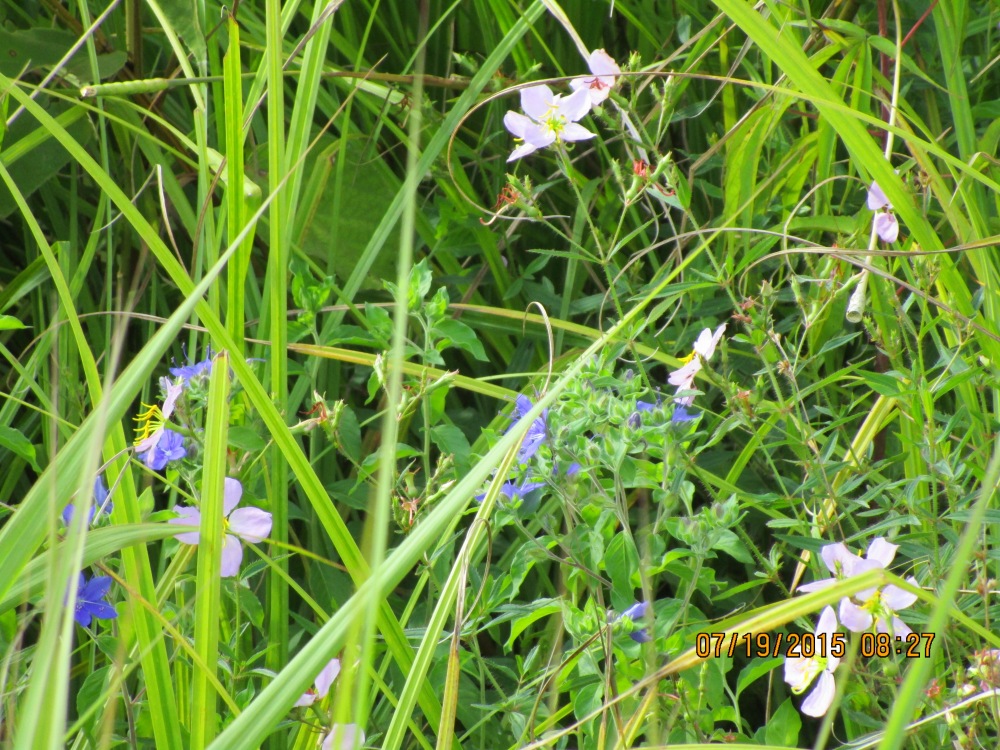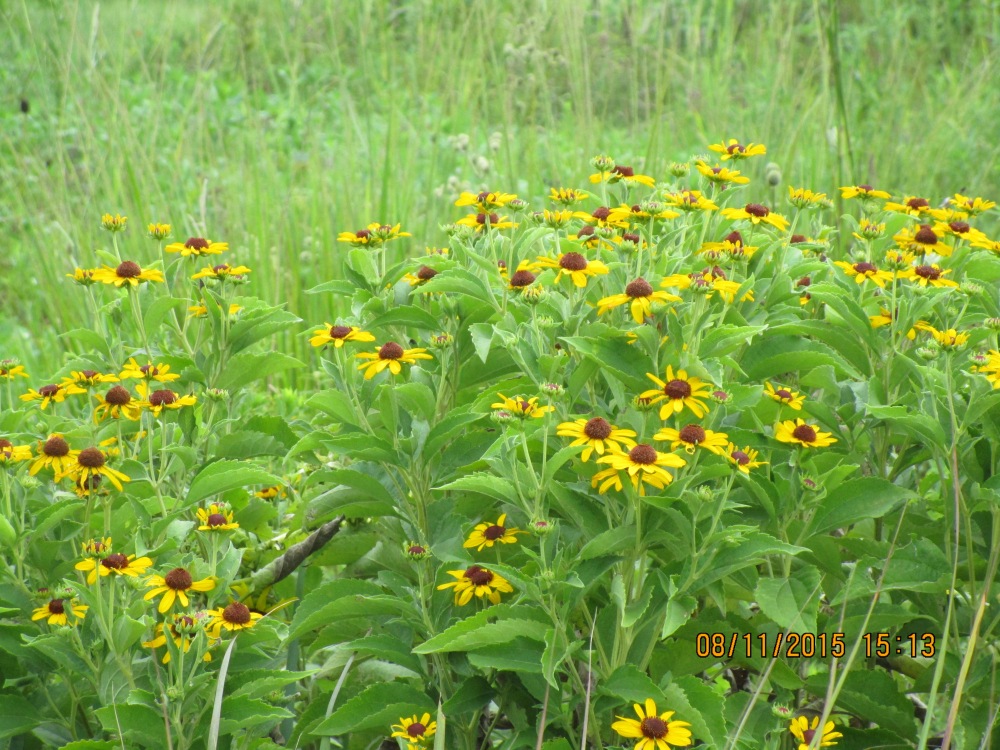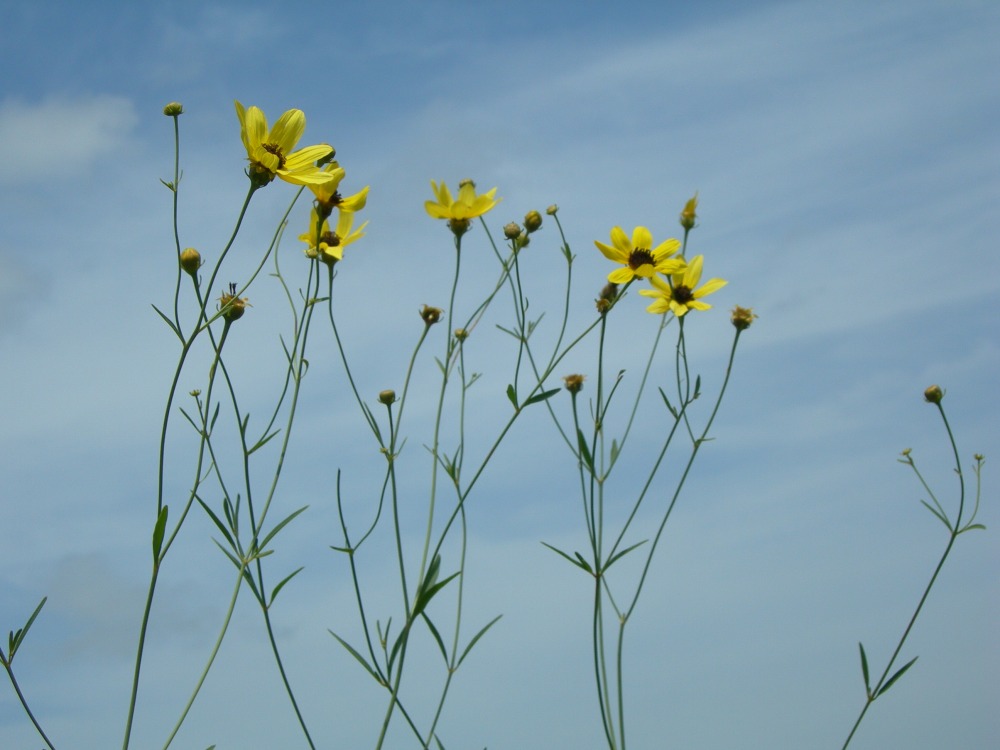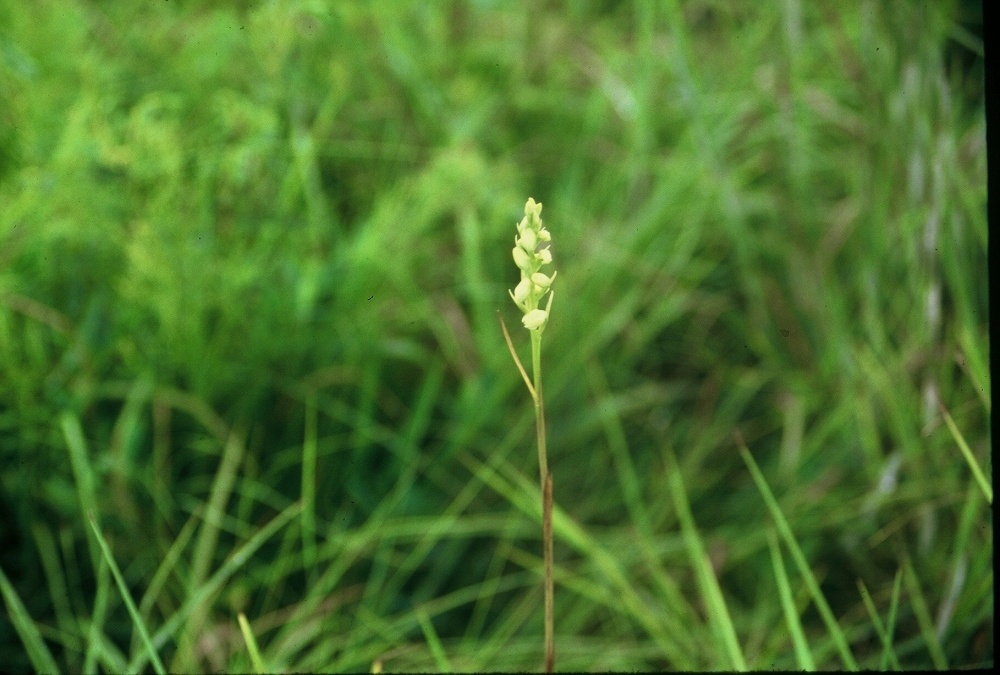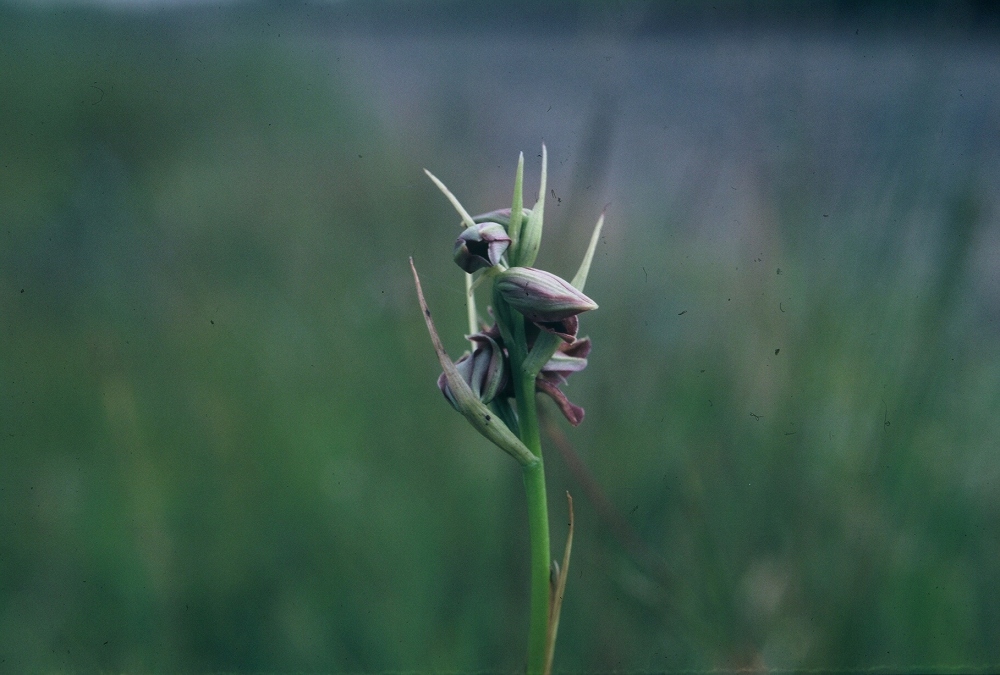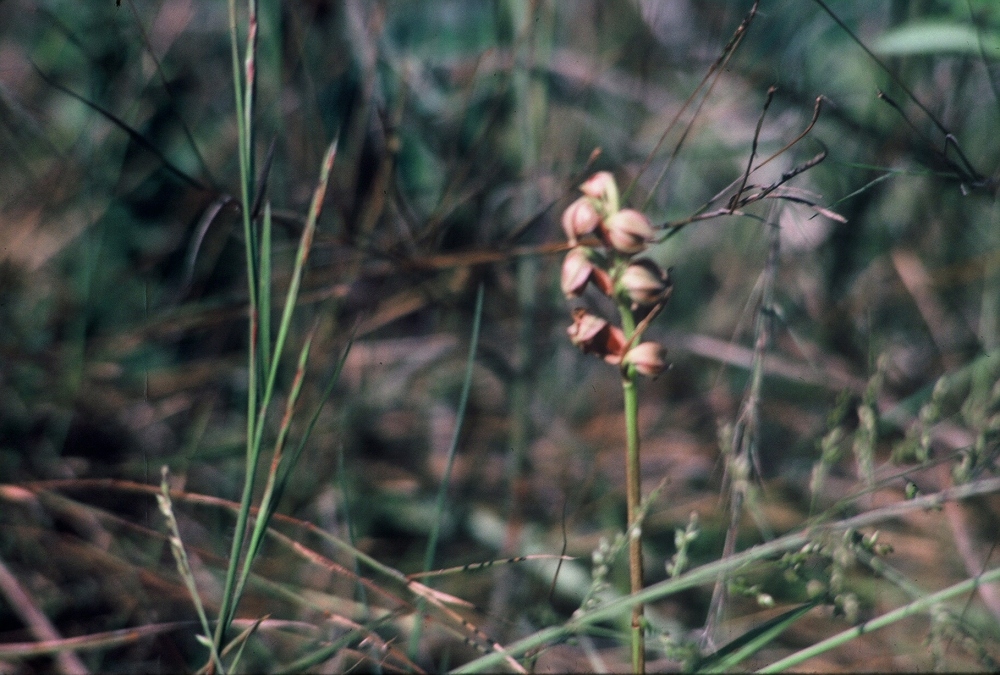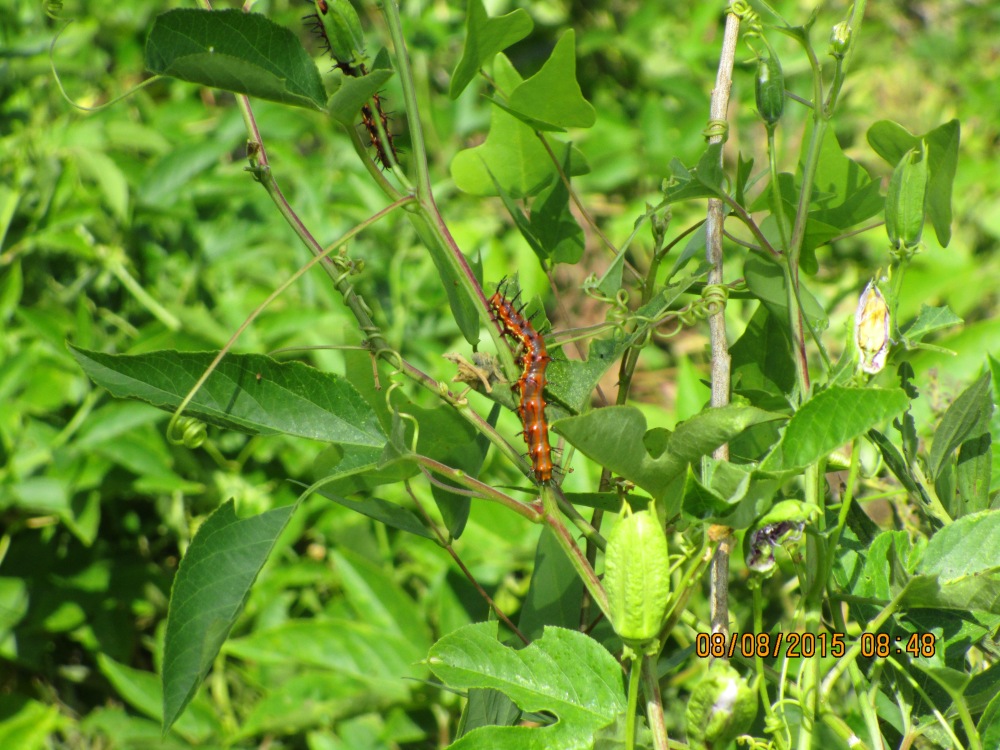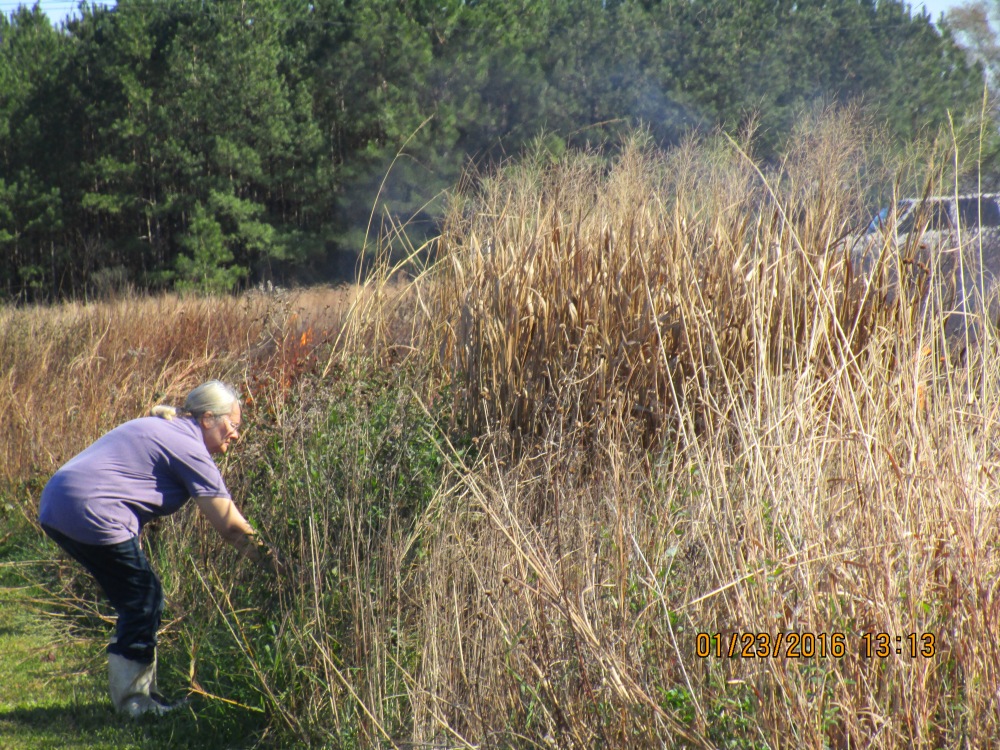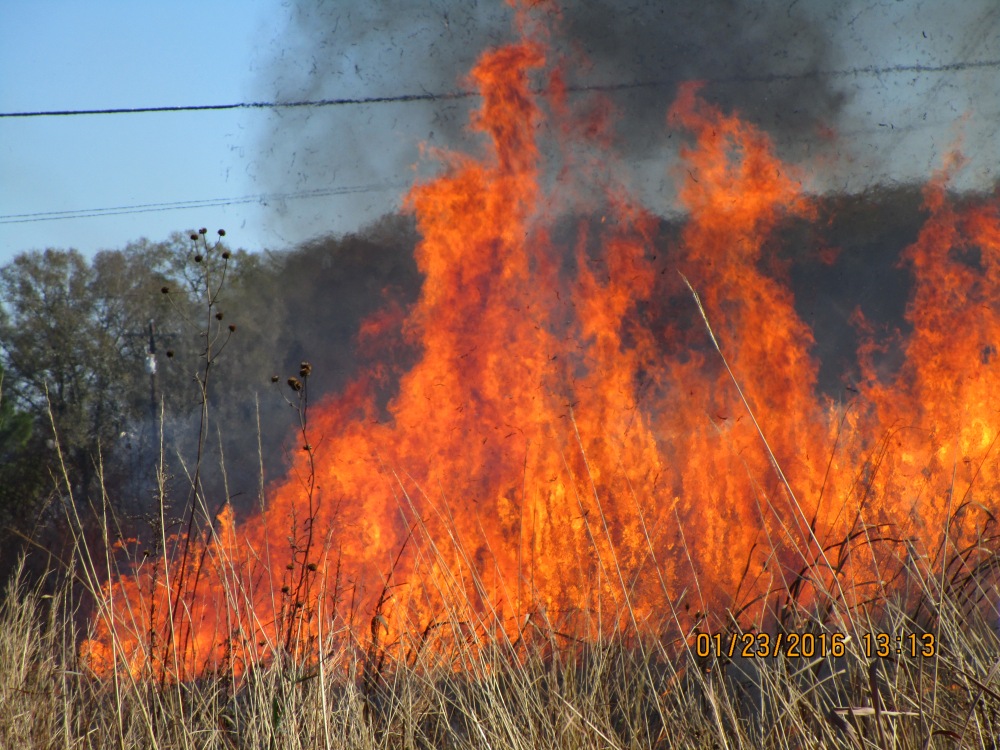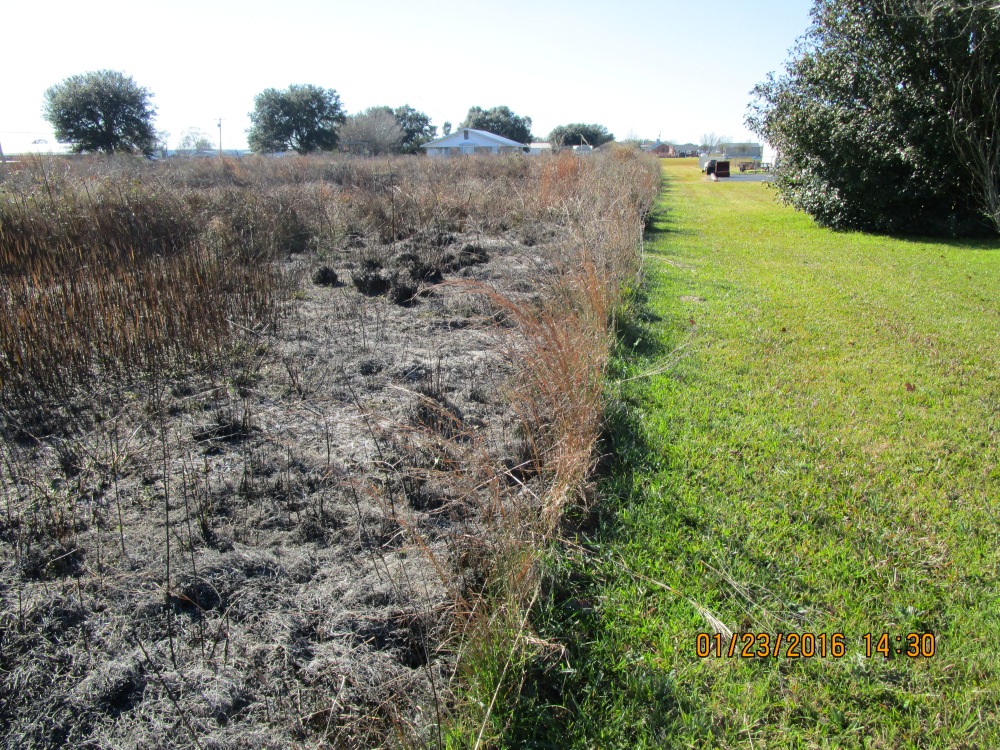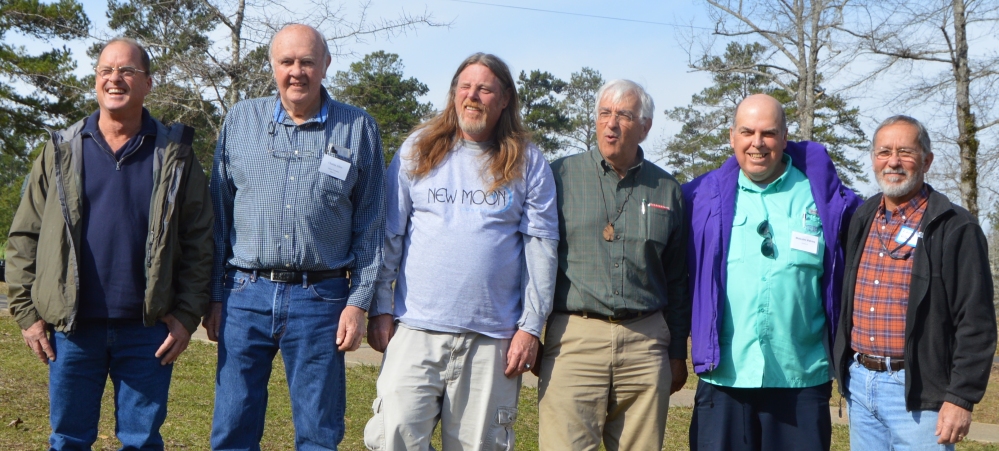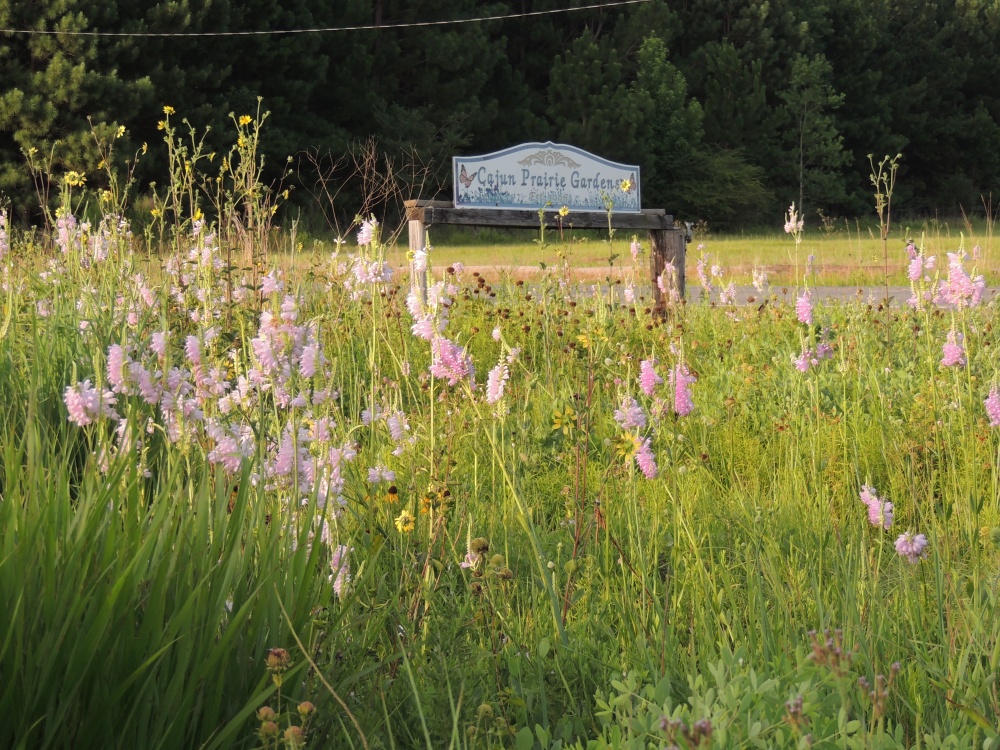
Early July in the Cajun Prairie Gardens. The pink blooms are Obedient plant.
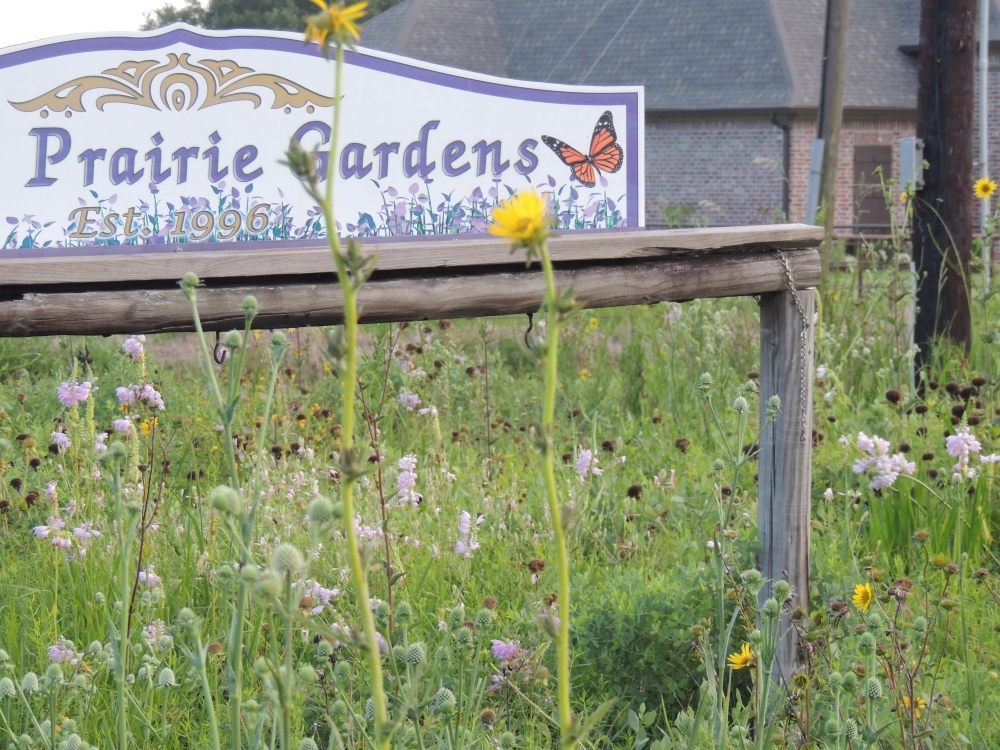
The first blooms of Compass plant appear.
July is a prairie that is 6 feet tall in many places. For the first week of the month, Physostegia and Hibiscus are in elegant bloom. Several species begin reaching for 7-8 feet and will probably achieve 9-10 feet by the end of the season. The weather is now hot and humid, and the prairie becomes unpleasant during the heat of the day; however, the prairie remains beautiful. In the gardens, the number of butterflies begins increasing and continues to do so until October. July begins looking like June and ends looking like August—mid-July appears with somewhat of a lull in activity in blooming as the transition occurs from fantastic views of Obedient plants in dry prairie to masses of sunflowers, and the wet prairie’s Crimson-eyed rosemallows wane and are replaced by short bloomers hidden among the rosemallows’ debris.

Dr. Charles Allen in Midland prairie remnant in July 1987. Compass plants bend over in the foreground, while Ovateleaf Indian plantains and Dense blazing stars dot the background.
Silphium laciniatum (Compass plant) is a very special plant for several reasons. One, it has a huge tap root, up to 15 feet in length based on reports from the Midwest; 2, it has these remarkable laciniate leaves that turn their broad side to the sun and point their edges north and south, thus giving rise to its name, Compass plant; 3, it begins blooming as July opens—a week earlier in some cases, you will see a single flower open. This latter item connects the great prairies of the Midwest with those of the south, in that this plant also blooms on or around July 1st in Iowa and Minnesota. When you examine the bloom seasons of these prairies, it is obvious that the northern prairies bloom for 5-6 months while the southern prairies bloom for 9-10 months. The northern prairies have their blooming plants bunched up, while the southern prairie has several bloom flushes followed by lulls. In our Cajun Prairie, plants start blooming in early March and end in early November, whereas in the Midwest, blooms appear in May and end in September. When you compare genera (and some species) of specific plants, a distinct pattern is observed, e. g., Monarda fistulosa (Bergamont beebalm) blooms in June and July in the Midwest and in April to June in the Cajun Prairie. Thus you can see that the times are offset, but on July 1, the prairies of the Midwest and the South appear to align for a few weeks and enter a synchronicity, which is best evidenced by the Compass plant’s blooming. Why does this happen? In ecology, we learn that every part of the globe receives roughly the same amount of sunlight on a yearly budget, but the equator get 12 hours a day all year long, while Louisiana gets 12 hours a day only in March and September (equinoxes), but Louisiana gets 10 hours a day in December and 14 hours a day in June. In the upper Midwest, these numbers begin to show extremes, with 8 hours a day in December and 16 hours a day in June, and by the time, you get to Alaska and Canada, you are talking about 2-4 hours or less in December and 20-22 or more in June. In the end, a simple equation appears and relates plant growth and internal signaling for flowering based upon day length such that our Compass plants mature and bloom after receiving a half of a year of the daylight budget; other plants mature and bloom when varied units of the budget are used giving us short-day bloomers and long-day bloomers. Thus the prairie phenology of flowering is tied not only to time but also to seasons, aka latitudes. Thus no 2 prairies are identical in the phenologies. And any other features in the prairie, from hillsides to shade from rocks, etc., can alter bloom times. And of course, any insult, burning or mowing, can highly change the bloom times by restarting clocks and sending new chemical signals throughout the plants.
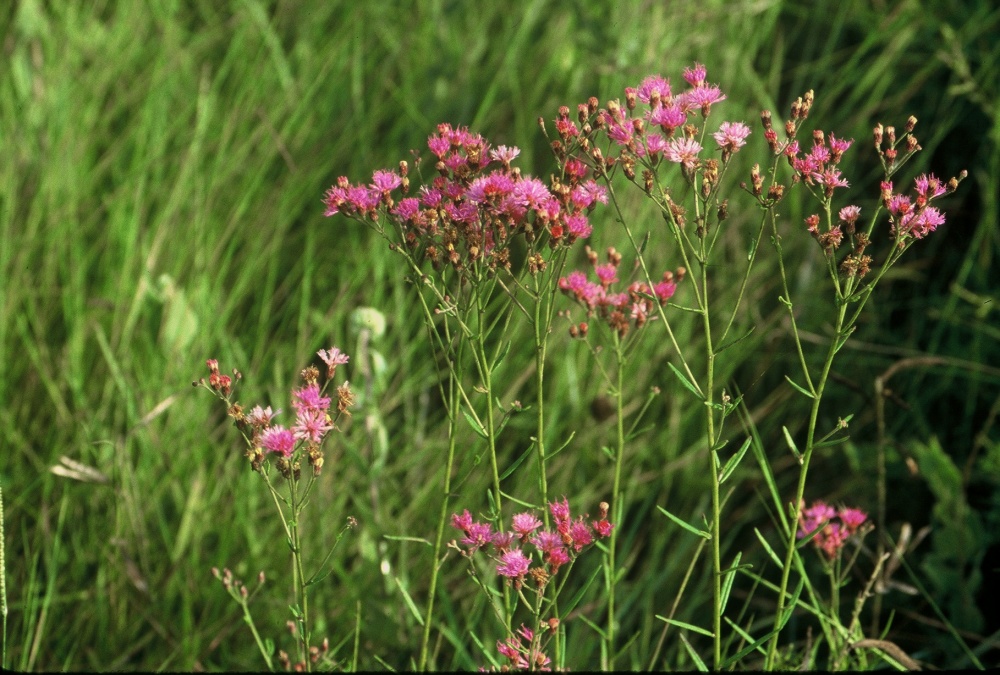
Vernonia texana (Texas ironweed) is an early blooming ironweed in the Cajun Prairie. It is smaller and less showy but similar to the late blooming Vernonia gigantea (Giant ironweed).
Spring and early summer sunflowers (Cirsium, many Coreopsis, Echinacea, Senecio, Krigia, many Rudbeckia, etc.) complete their blooming. July begins a fantastic season of sunflowers, the Asteraceae or Compositae. Many new genera of sunflowers bloom, not only the typical sunflowers (Helianthus, ‘Aster,’ Silphium, Bidens, Rudbeckia, Chrysopsis, Pityopsis, Boltonia, Gaillardia, Coreopsis, etc.) but also the atypical sunflowers (Liatris, Vernonia, Conclinium, Arnoglossum (Cacalia), Eupatorium, Euthamia, Pluchea, Mikania, Solidago, Oligoneuron, etc.). For the next 5 months, these sunflowers rule the prairie floralscape.
By the middle of the month, Arnoglossum (Cacalia), Coreopsis tripteris (Tall tickseed), Rudbeckia subtomentosa (Sweet black-eyed susan) and Liatris begin blooming. Silphium laciniatum becomes the significant sunflower, but its shorter relative, Helianthus mollis (Ashy sunflower), begins to make a show. Silphium gracile continues to bloom—it blooms from April to November, and it will rebloom if mowed.
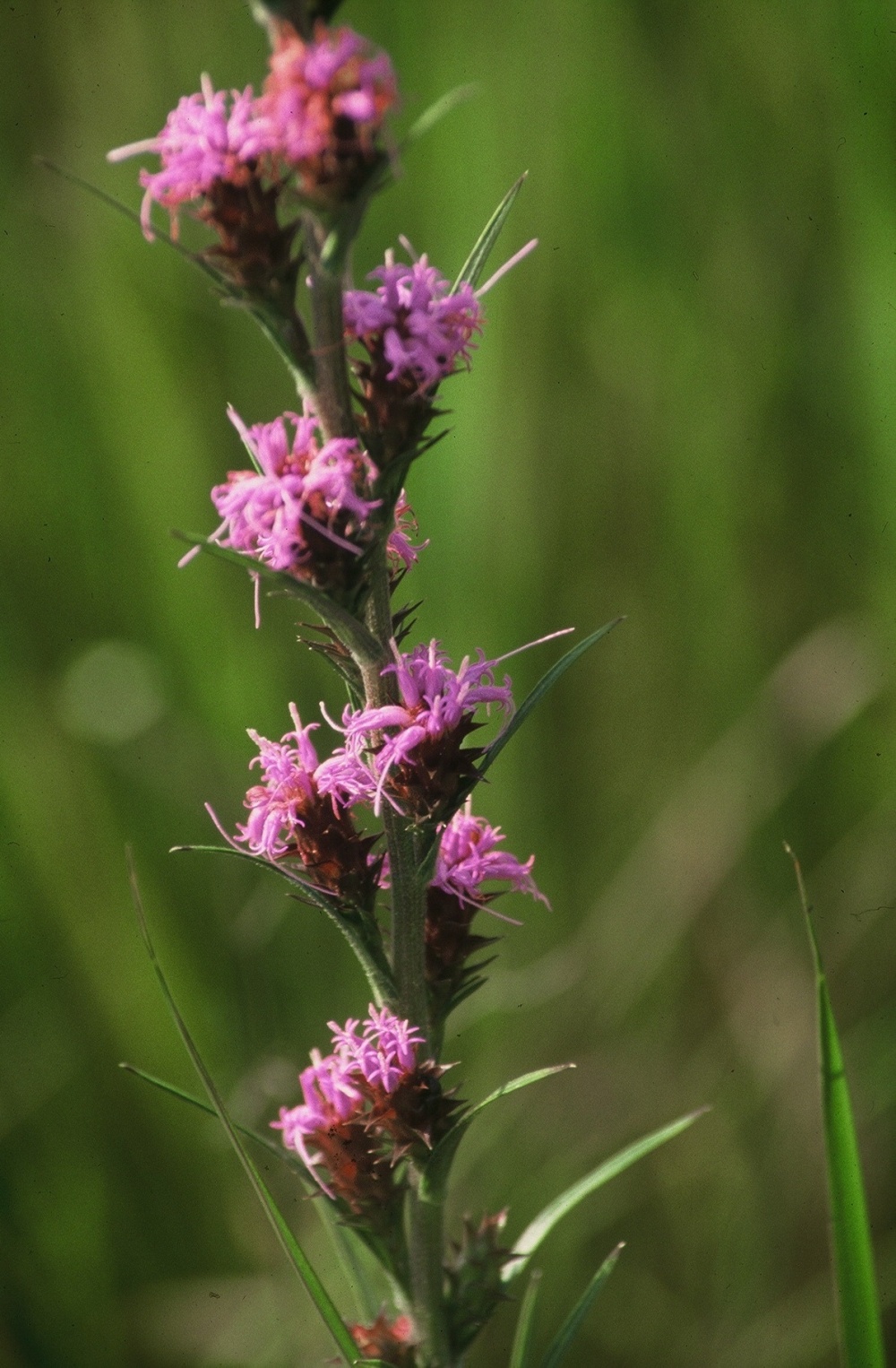
Liatris squarrosa (Button blazing star).
July begins the season of blooming blazing stars—the Liatris. Liatris contains many species of truly elegant sunflower species that bloom in linear spikes from the apical tip down to mid-spike or lower over a few weeks. The species in the Cajun Prairie bloom from early July to early October. By far the most abundant species in the Cajun Prairie were L. spicata (Dense blazing star) in the southern prairies and L. pycnostachya (Prairie blazing star or Kansas gayfeather) in the western prairies. Dense blazing stars from the Midland remnant prairie photograph either blue or red depending on the lighting, and some are white as in the center of these two pictures.
Less common, Liatris acidota (Slender blazing star) and L. squarrosa (Button blazing star) start blooming during the early part of the month and continue to bloom until late September. These bloom for a much longer period than the other species. Dense blazing star blooms mostly in July and August, whereas Prairie blazing star blooms from late August to early October, and L. elegans (Pinkscale blazing star) blooms from late September into October.
Overlap in their blooms is evident, and hybrids of Liatris may exist, but that is far beyond our focus. Occasional albino (white) flowering plants are found in the Cajun Prairie. The flowers of all the species are generally pink to purple, but they may appear blue or red on photographic film at different times of the day. My eyes were often forced to take a double take to confirm the color. These plants are also a major group in the florist palette and are commonly found in arrangements. They dry beautifully when stored upside-down. The plants are easily started from seed, but they like disturbed soils for that first start. They live for decades, and they can be really impressive in numbers and size. There are approximately 50,000 plants, mostly Liatris pycnostachya, in the Cajun Prairie Restoration Project in Eunice. For 3 months, from mid-July to mid-October, you are sure to see at least one species in bloom—which one(s) will tell you not only which month you are in but also maybe which week. Charles Allen once hailed these blazing stars as the most common wildflowers in Louisiana. I remain totally impressed by them.

Mid-July 1987, Midland prairie remnant contains lots of Rattlesnake master and Ovateleaf Indian plantain.
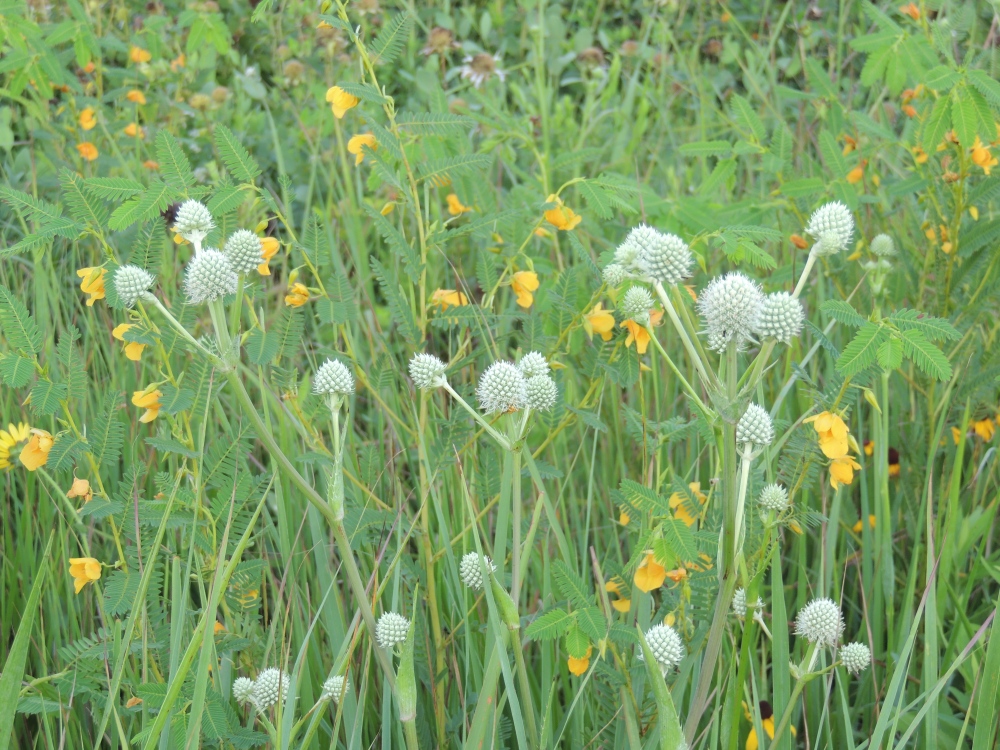
Rattlesnake master (white) with Partridge pea (Chaemescrista fasciculata).
Eryngium yuccifolium (Rattlesnake master or Button snakeroot or Button eryngyo) blooms in dry prairie, and Hydrolea ovata (Blue waterleaf) blooms in wet prairie. Rattlesnake master, a member of the carrot family, attracts pollinators by the hundreds of species and spreads as the prairie soils mature. Its prickly clusters of white flowers are unmistakable as is its yucca-like rosette of leaves. This plant is a great indicator of prairies. Blue waterleaf is a striking blue beauty (sometimes light blue or white) with bonafide stickers—it spreads well in wet areas and will literally put on a great show of color.
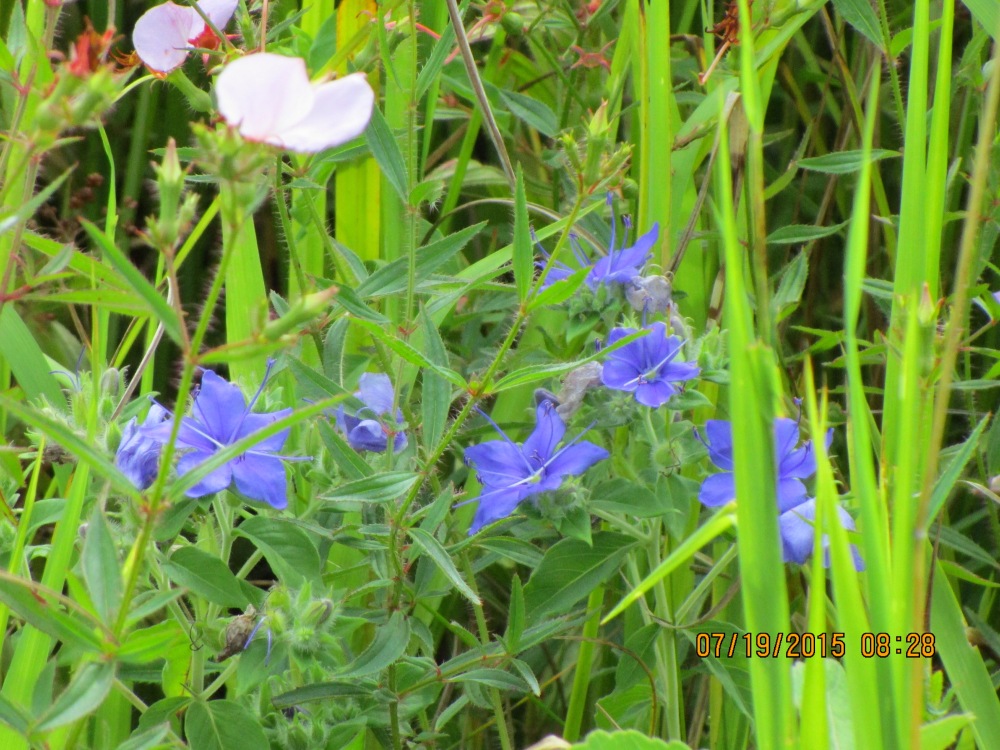
Blue waterleaf.
Tall tickseeds and Sweet black-eyed susans represent 2 groups of sunflowers that were very common in Spring. Just when it appears that we have lost all blooms of the tickseeds and black-eyed susans (only stragglers remain unless someone has mowed or burned), these 2 late bloomers surprise us with an explosion of blooms. Whereas Tall tickseeds reach 8 or more feet in height, the Sweet black-eyed susans are roughly 4-5 feet tall. Both put on a tremendous show. Both are easily propagated from stem cuttings.
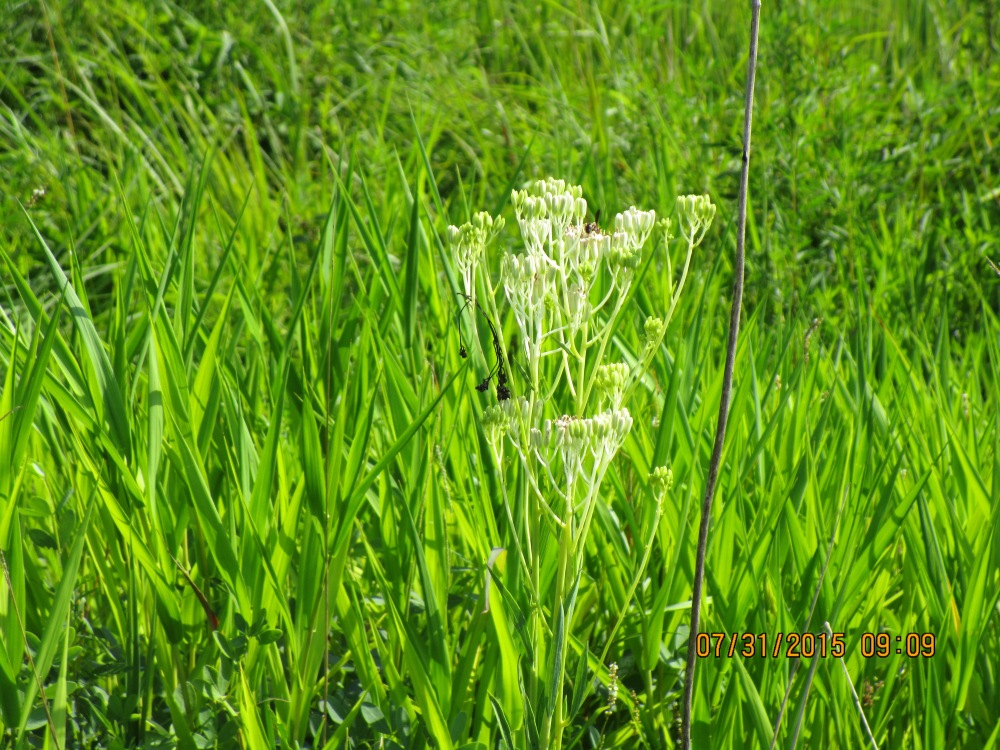
Ovateleaf Indian plantain.

Asclepias lanceolata (Fewflower milkweed) surrounded by Ovateleaf Indian plantain in remnant prairie.
Arnoglossum (Cacalia) ovatum (Ovateleaf Indian plantain) can form large clusters of white flowers. In the remnant prairies south of Interstate 10, it often was companioned by Dense blazingstar, where they formed fields of white and blue-purple blooms at the end of month.
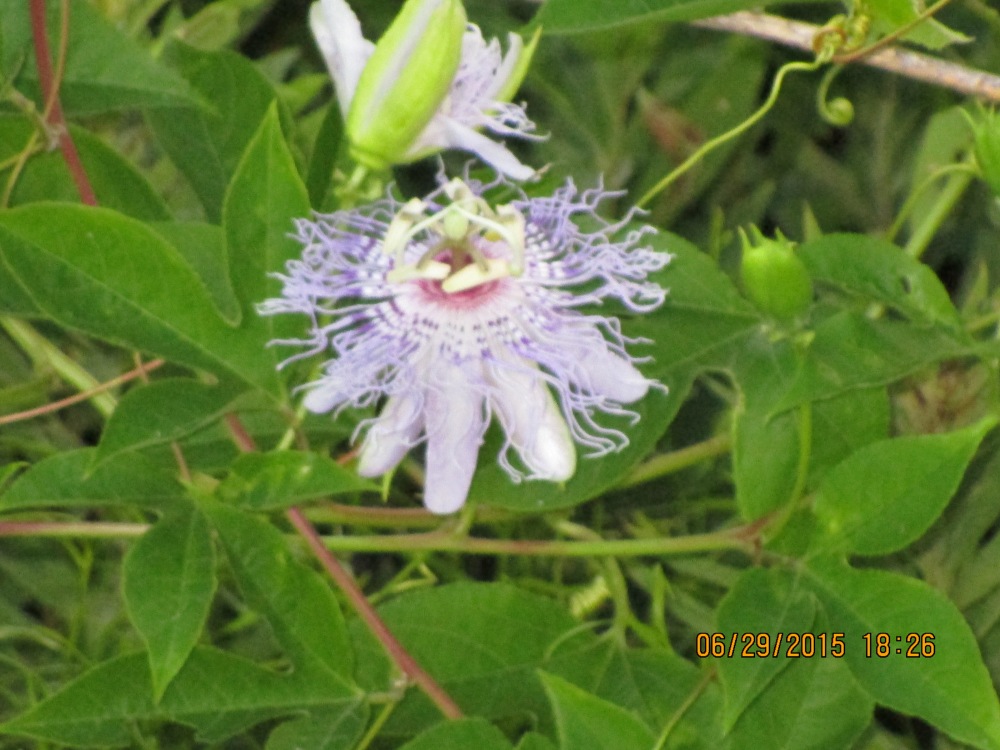
Passionvine.
Passiflora incarnata (Passionvine), the host for Gulf fritillary butterflies, is blooming its famous ‘Crucifixion flowers’ with their elegant frills and details, which open late in the afternoon. Some years, caterpillars are abundant and literally eat all of the leaves. The fruit are tasty when ripe, and seeds planted with the tasty pulp germinate within days of planting. This plant really likes compost, where it will grow with a vengeance and provide the backbone for a prairie garden of butterflies. The Gulf fritillary was the most common butterfly in my butterfly surveys of the Cajun Prairie—probably because the Passionvine was spread by birds and commonly found its way into available roadsides and pastures and any abandoned field with suitable soil—suitable soil is becoming rare as is this plant in some areas.
As July ends, the big grasses begin reaching for the sky. In prairies with lots of the big grasses, Big bluestem, Switchgrass, etc., the grasses will begin to overwhelm our view—this is certainly true in the Cajun Prairie Gardens. Whereas in the Cajun Prairie Restoration Project in Eunice, the emphasis is on Little bluestem and shorter grasses, and thus it has a greater meadow quality with many more obvious blooming forbs. Gardens vary greatly based upon not only the grasses but also the forbs that they contain. Native prairie was a grand mix of all these features, and it spread over millions of acres.
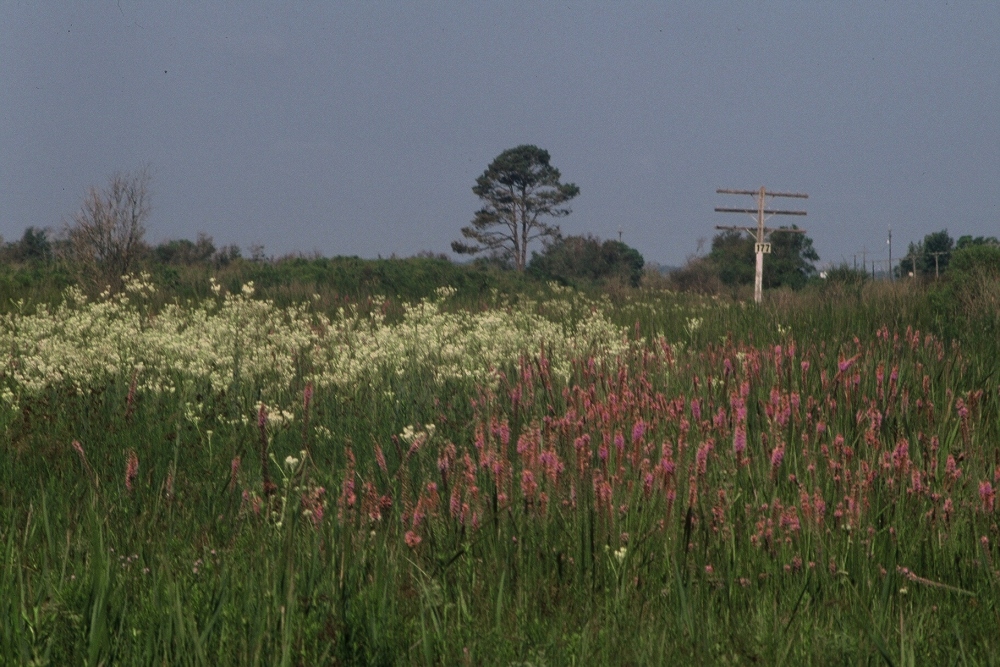
By month’s end, Midland prairie remnants were full of sunflowers, Ovateleaf Indian plantain (white) and Dense blazing star (pink)
What was blooming in the Cajun Prairie Gardens on July 1, 2015?
- *Silphium laciniatum
- Silphium gracile
- Asclepias tuberosa
- Asclepias perennis
- Asclepias lanceolata
- Gaura lindheimeri
- Callirhoe papaver
- Asclepias viridis
- Rudbeckia hirta
- Rudbeckia grandiflora
- Coreopsis tinctoria
- Mimosa hystricina
- Crinum americanum
- Ludwigia sp.
- Ruellia spp.
- Euphorbia corallata
- Conoclinium coelestinum
- Tephrosia onobrychoides
- Monarda fistulosa
- Monarda lindheimeri
- Rudbeckia hirta
- Rudbeckia grandifolia
- Asclepias verticillata
- Sabatia spp.
- Hypericum spp.
- Thalea dealbata
- Eryngium yuccifolium
- Physostegia digitalis
- Hibiscus moscheutos lasiocarpus
- Kosteletskia virginica
- Hibiscus coccinea
- Ipomoea sagittata
- Chamescrista fasciculata
- *Passiflora incarnata
- Canna spp.
- *Coreopsis tripteris
- *Helianthus mollis
- *Liatris acidota
- *Manfreda virginica
- *Salvia azurea
- *Hydrolea ovata
- Pycnanthemum tenuifolium
- Pycnanthemum muticum
- Rhexia mariana
- Lythrum lineare
- Cephalanthus occidentalis
- Galactea volubilis
- Gaillardia aestivalis
- Lippia sp.
*first blooms apparent
Posted by M. F. Vidrine 021016 (malcolmvidrine@yahoo.com)
